Juice Manufacturing Process
13 Sustainable Solutions for Juice Packaging and Storage
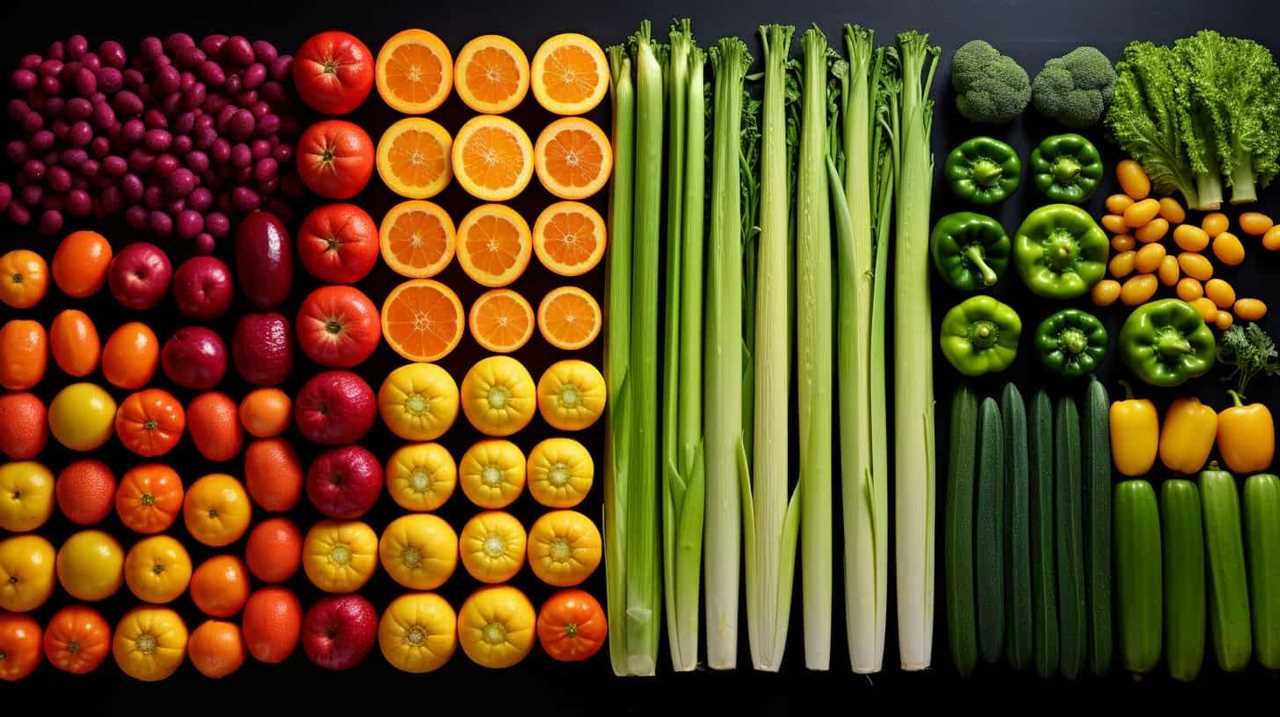
Are you fed up with disposable juice packaging that damages the environment? Look no further, as we present to you 13 eco-friendly alternatives for juice packaging and storage.
Imagine sipping your favorite juice from a biodegradable bottle or pouring it from a recyclable carton.
Picture storing your juice in compostable pouches or reusable jars.
With our eco-conscious options like glass containers and dispensers, you can enjoy your juice guilt-free.
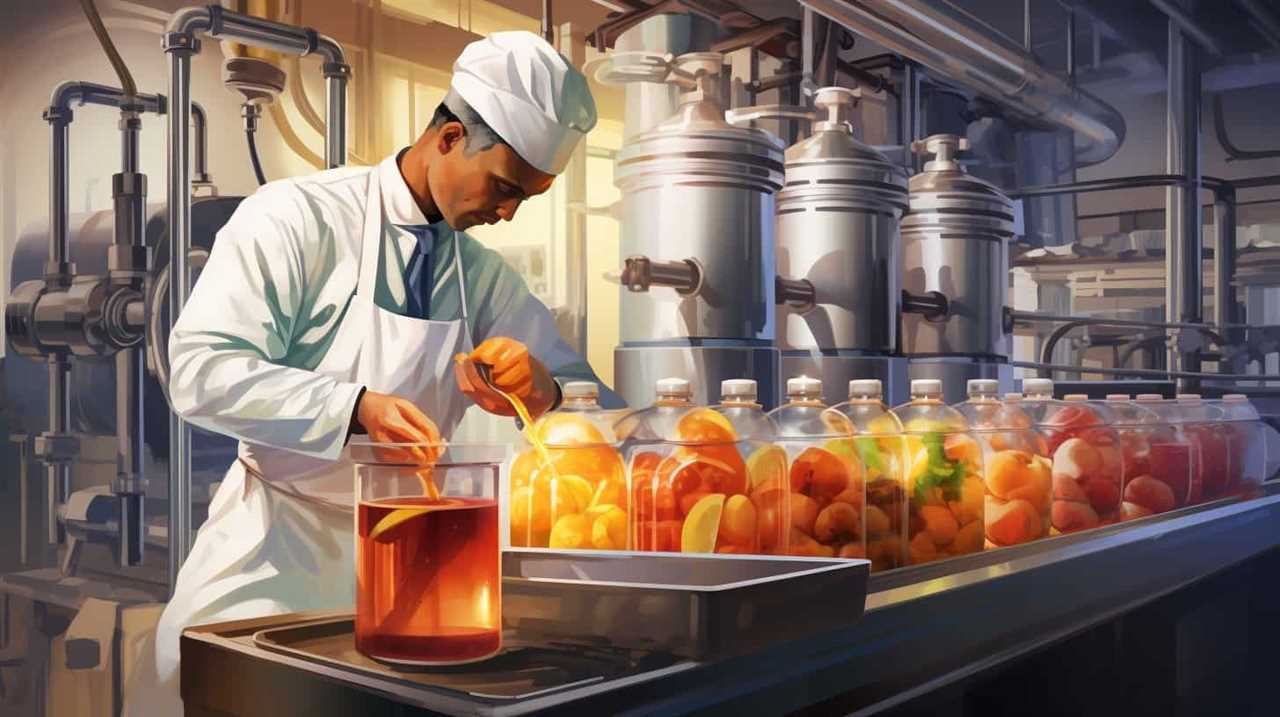
Join us as we explore these ethical and eco-friendly juice packaging materials and accessories that serve both you and the planet.
Key Takeaways
- Sustainable packaging materials such as biodegradable juice bottles, recyclable juice cartons, compostable juice pouches, and sustainable glass containers are key solutions for reducing waste in juice packaging.
- Building robust recycling infrastructure, improving accessibility, and educating consumers about recycling are crucial steps in promoting sustainable juice packaging.
- Reusable and innovative packaging solutions like reusable juice jars with unique lid designs and eco-friendly bag-in-box options offer alternatives to single-use packaging.
- Minimalist and efficient juice storage options, such as stackable bottles and organized dispensers, help prevent wastage and optimize storage space.
Biodegradable Juice Bottles
We frequently use biodegradable juice bottles as a sustainable solution for packaging and storing our juices. These bottles are made from materials that can break down naturally over time, reducing their impact on the environment. Not only do biodegradable juice bottles help to minimize waste, but they also contribute to the overall sustainability of our business.
Additionally, we’ve taken steps to further enhance the eco-friendliness of our packaging by introducing biodegradable juice straws and sustainable juice bottle labels. These innovations ensure that every aspect of our product is designed with the environment in mind, allowing us to serve our customers while also reducing our ecological footprint.
Recyclable Juice Cartons
When it comes to sustainable juice packaging, recyclable cartons present an eco-friendly option that can help reduce waste and minimize environmental impact.
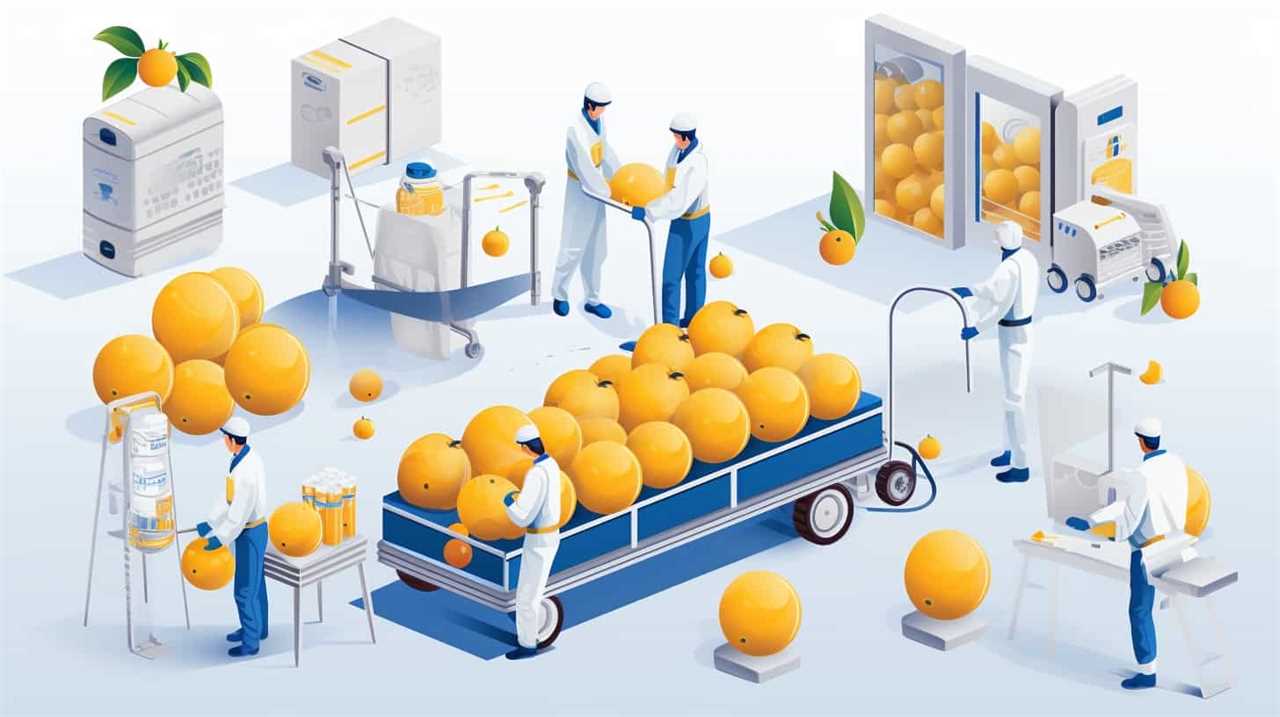
However, the effectiveness of recyclable juice cartons relies heavily on the availability and accessibility of recycling infrastructure.
To ensure widespread adoption and successful recycling, it’s crucial to invest in improving recycling facilities and educating consumers about the importance of recycling and proper disposal of these cartons.
Eco-Friendly Packaging Options
As we explore sustainable solutions for juice packaging and storage, it is important to consider eco-friendly options, such as recyclable juice cartons. These cartons are made from materials that can be easily recycled, reducing the amount of waste that ends up in landfills. Additionally, recyclable juice cartons can help conserve resources and reduce greenhouse gas emissions compared to traditional plastic bottles. To provide a visual representation of ideas, here is a table showcasing some eco-friendly packaging options:
| Packaging Option | Benefits | Drawbacks |
|---|---|---|
| Recyclable juice cartons | Easily recyclable, reduces waste, conserves resources | Limited availability, may have higher production costs |
| Biodegradable juice straws | Breaks down naturally, reduces plastic waste | Limited durability, may be more expensive |
| Sustainable juice labels | Made from eco-friendly materials, reduces environmental impact | Limited design options, potentially higher cost |
Recycling Infrastructure and Accessibility
To ensure widespread recycling of recyclable juice cartons, it’s essential to establish robust recycling infrastructure and improve accessibility. Currently, many communities lack the necessary infrastructure to effectively recycle juice cartons, leading to low recycling rates.
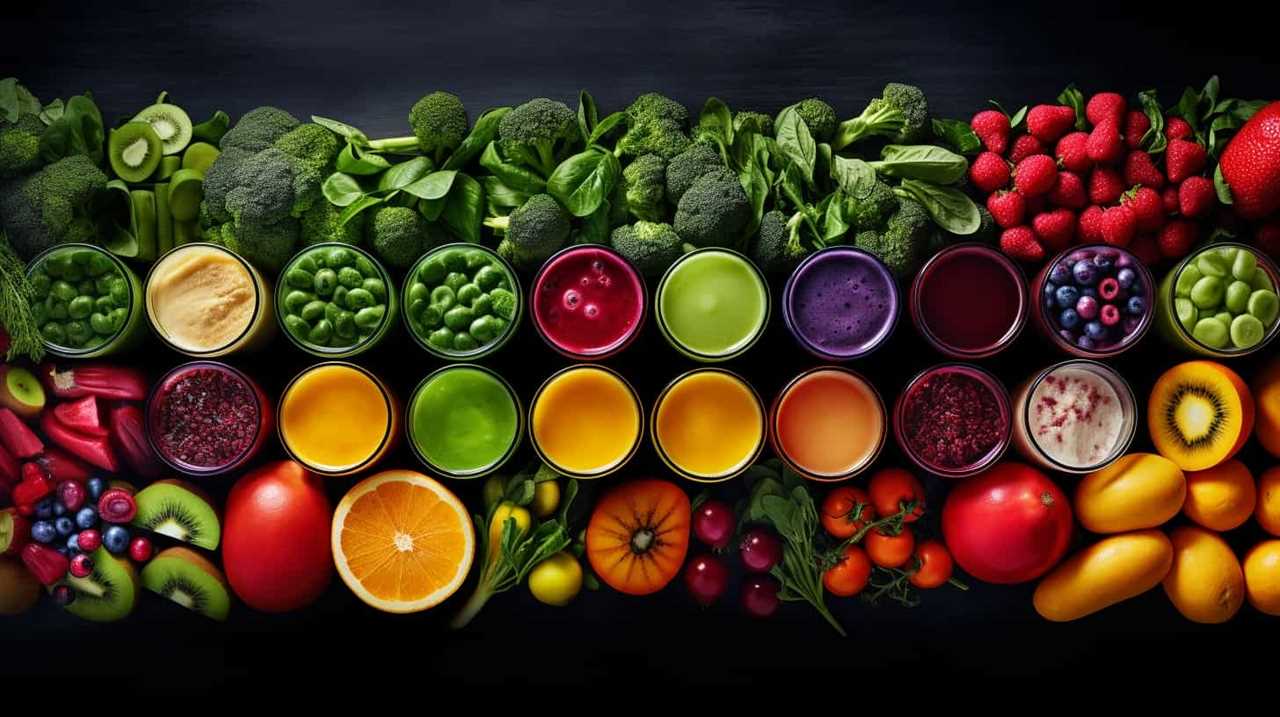
To address this issue, recycling campaigns can be implemented to raise awareness among consumers about the importance of recycling and provide clear instructions on how to properly dispose of juice cartons. Additionally, local recycling programs should be expanded to include the collection and processing of juice cartons. This can be achieved through partnerships with recycling facilities and waste management companies.
Consumer Awareness and Education
Improving consumer awareness and education is crucial for promoting the recycling of juice cartons. In recent years, consumer behavior has shifted towards a greater emphasis on sustainability and environmental responsibility. As a result, sustainable packaging trends have gained traction, with consumers actively seeking out products with eco-friendly packaging options.
However, despite the availability of recyclable juice cartons, many consumers remain unaware of the proper recycling methods and the benefits of recycling. To address this issue, it’s essential to educate consumers about the recyclability of juice cartons and the importance of recycling. This can be done through various channels such as social media campaigns, educational materials at point of sale, and partnerships with local recycling facilities.
Compostable Juice Pouches
We have found a promising solution for sustainable juice packaging and storage: compostable juice pouches. These innovative pouches are made from plant-based materials that break down naturally in composting facilities, reducing waste and environmental impact.
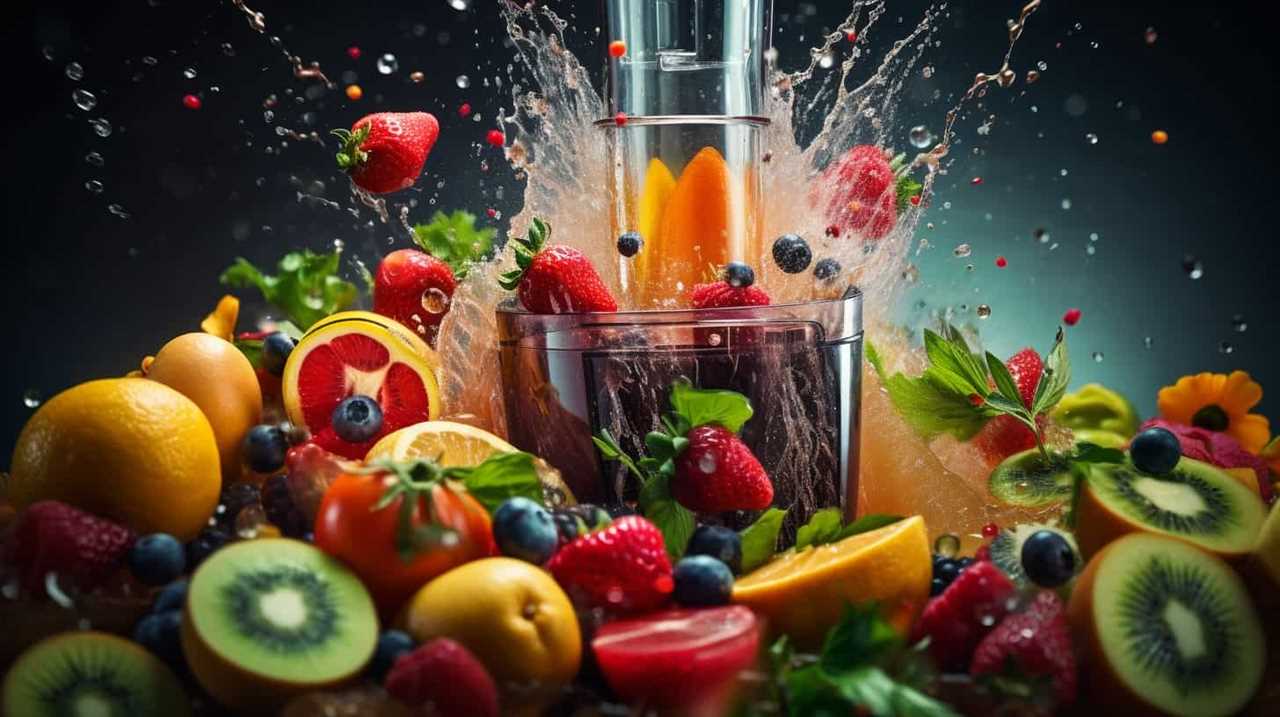
Here are two key benefits of using compostable juice pouches:
- Compostable juice straws: Along with the pouches, we can also introduce compostable juice straws. These straws are made from materials like paper or PLA (polylactic acid), which decompose quickly and can be composted along with the pouches. By opting for compostable straws, we can further reduce the use of single-use plastic and promote a more sustainable drinking experience.
- Sustainable juice labeling: In addition to the compostable materials used for the pouches and straws, it’s essential to consider sustainable labeling options. By using eco-friendly labels made from recycled or biodegradable materials, we can ensure that the entire packaging is environmentally friendly. This approach aligns with our commitment to serving others by reducing our ecological footprint and promoting a healthier planet.
Sustainable Glass Juice Containers
Continuing the exploration of sustainable juice packaging, we can now delve into the topic of utilizing sustainable glass juice containers.
Biodegradable glass containers and reusable glass bottles are excellent alternatives to single-use plastic bottles. Glass is a highly sustainable material as it’s 100% recyclable and can be reused countless times without losing its quality. Unlike plastic, glass doesn’t release harmful chemicals into the environment, making it a safe choice for both consumers and the planet.
Additionally, glass containers can be easily sterilized and reused, reducing waste and promoting a circular economy. By opting for biodegradable glass containers and reusable glass bottles, we can significantly reduce the environmental impact of juice packaging while ensuring the safety of our health and the health of the planet.
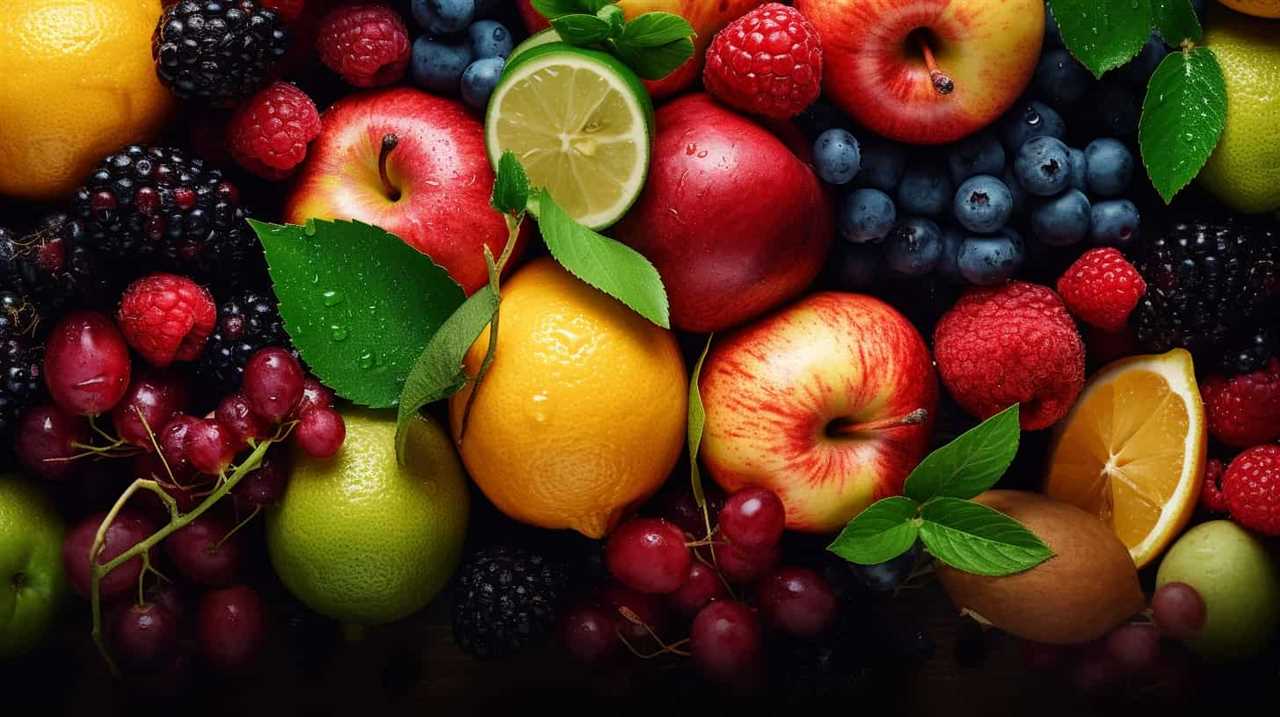
Reusable Juice Jars
When it comes to sustainable packaging solutions for juice, reusable jars offer a range of benefits.
Not only do they help reduce waste and minimize environmental impact, but they also contribute to cost savings in the long run.
Additionally, innovative designs in reusable jar packaging can enhance the overall consumer experience and promote brand loyalty.
Benefits of Reusables
As we explore sustainable solutions for juice packaging and storage, it’s important to consider the benefits of using reusable juice jars. Reusable bottle options are an excellent choice for those who are committed to reducing waste and minimizing their environmental impact.
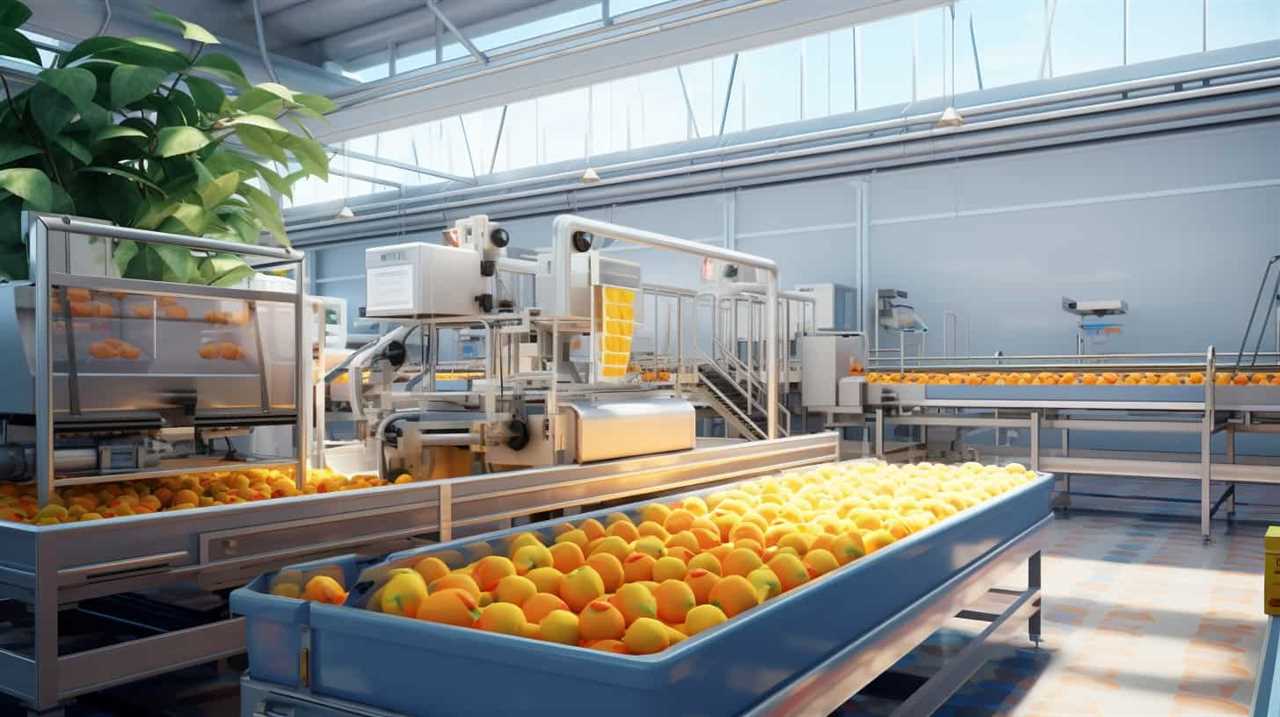
Here are a few reasons why reusable juice jars are a great option:
- Environmental impact: By opting for reusable juice jars, you can significantly reduce the amount of plastic waste generated. This contributes to sustainable packaging initiatives and helps protect our planet.
- Cost-effective: Investing in reusable juice jars may require an initial investment, but it can save you money in the long run. Instead of constantly purchasing single-use bottles, you can simply refill your reusable jar, saving you money over time.
Innovative Jar Designs
To explore innovative jar designs for reusable juice jars, we can consider various options that enhance sustainability and functionality.
In the quest for sustainable juice packaging, innovative lid designs play a crucial role. One such design is the twist-on lid with a built-in silicone seal, which ensures a tight and leak-proof seal, preventing any spillage and preserving the freshness of the juice.
Another option is the flip-top lid, which allows for easy pouring and closing, eliminating the need for additional tools or equipment.
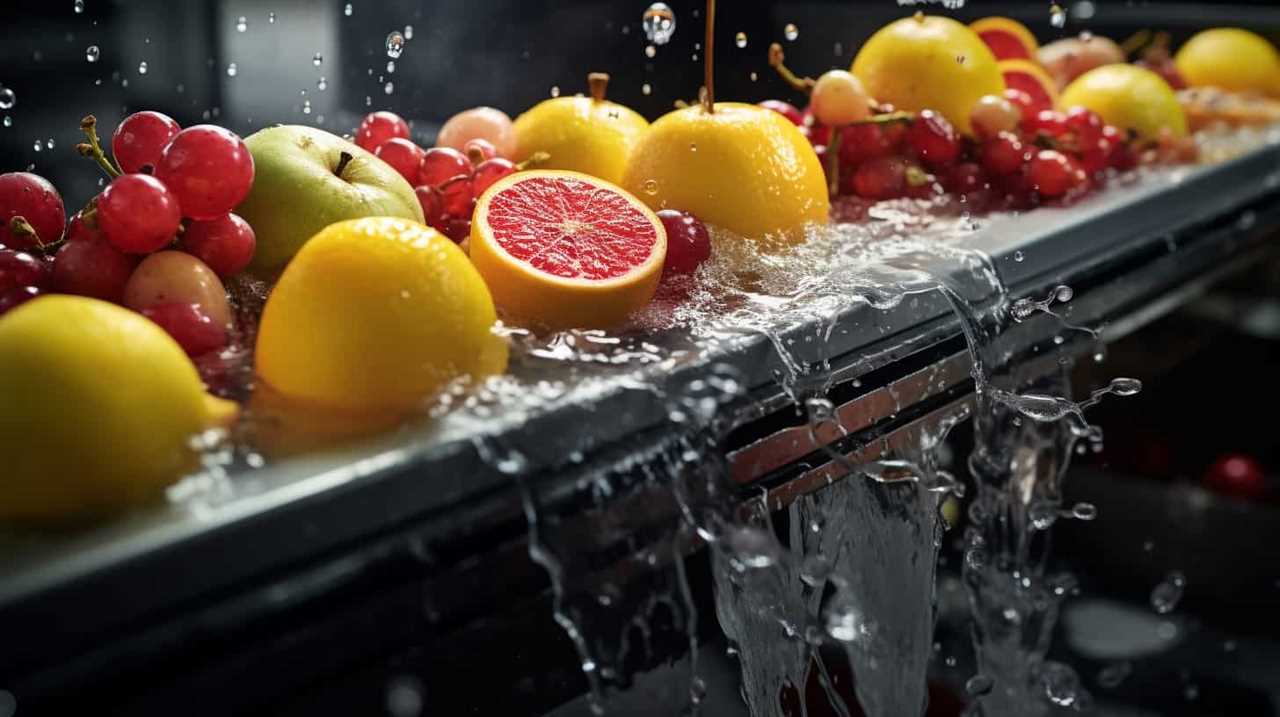
Additionally, some jars feature a wide-mouth design, making it easier to fill and clean.
These innovative lid designs not only enhance functionality but also contribute to sustainable juice packaging trends by promoting reusability, reducing waste, and minimizing the use of single-use plastic bottles.
Cost-Effective Alternatives
Our research has identified several cost-effective alternatives for reusable juice jars.
In our search for sustainable juice packaging innovations, we came across biodegradable juice pouches, which offer a convenient and eco-friendly option for juice storage. These pouches are made from plant-based materials and break down naturally over time, reducing waste and environmental impact. They’re lightweight and can be easily transported, making them ideal for on-the-go consumption. Additionally, biodegradable juice pouches are often more affordable compared to traditional glass jars, making them a cost-effective solution for both consumers and manufacturers.
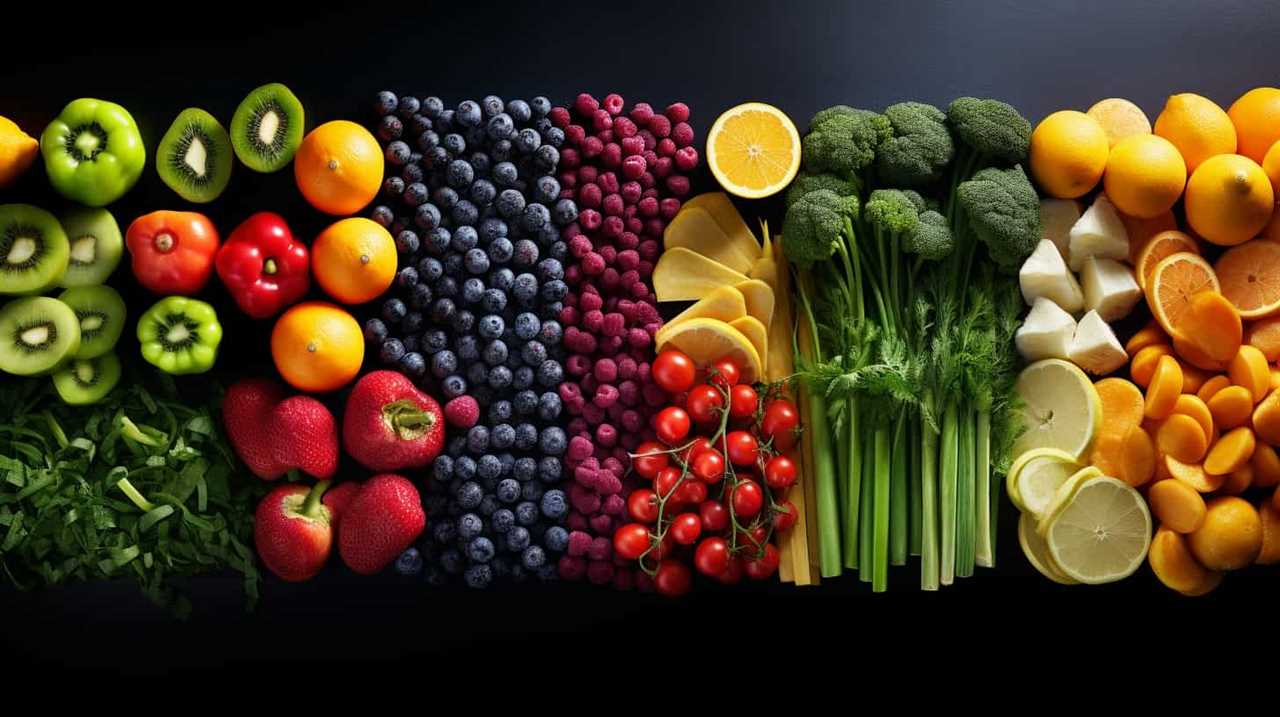
Another alternative is the use of innovative jar designs that are specifically designed for multiple uses. These jars are durable, leak-proof, and can be easily washed and reused, reducing the need for single-use packaging.
Plant-based Juice Packaging
We believe that plant-based juice packaging offers a sustainable alternative to traditional materials. By using biodegradable juice straws, we can reduce the environmental impact of single-use plastic straws. These straws are made from plant-based materials such as cornstarch or bamboo, which break down naturally over time.
Additionally, sustainable juice labeling techniques can be employed to minimize waste. Instead of using plastic labels, which can take hundreds of years to decompose, manufacturers can opt for biodegradable or compostable labels made from materials like sugarcane or recycled paper.
By implementing these plant-based packaging options, we can significantly decrease our reliance on non-renewable resources and reduce the amount of plastic waste that ends up in landfills and oceans.

Moving forward, let’s explore another eco-friendly solution: juice bag-in-box packaging.
Eco-Friendly Juice Bag-in-Box Solutions
When it comes to eco-friendly juice packaging solutions, one of the key aspects to consider is waste reduction.
By utilizing bag-in-box packaging, we can significantly reduce the amount of waste generated compared to traditional juice packaging options. These bag-in-box solutions typically involve a durable outer box and a flexible inner bag that holds the juice, allowing for easy dispensing and minimal product waste.
Additionally, an environmental impact assessment should be conducted to ensure that these bag-in-box solutions are truly sustainable and have a lower overall environmental footprint compared to other alternatives.
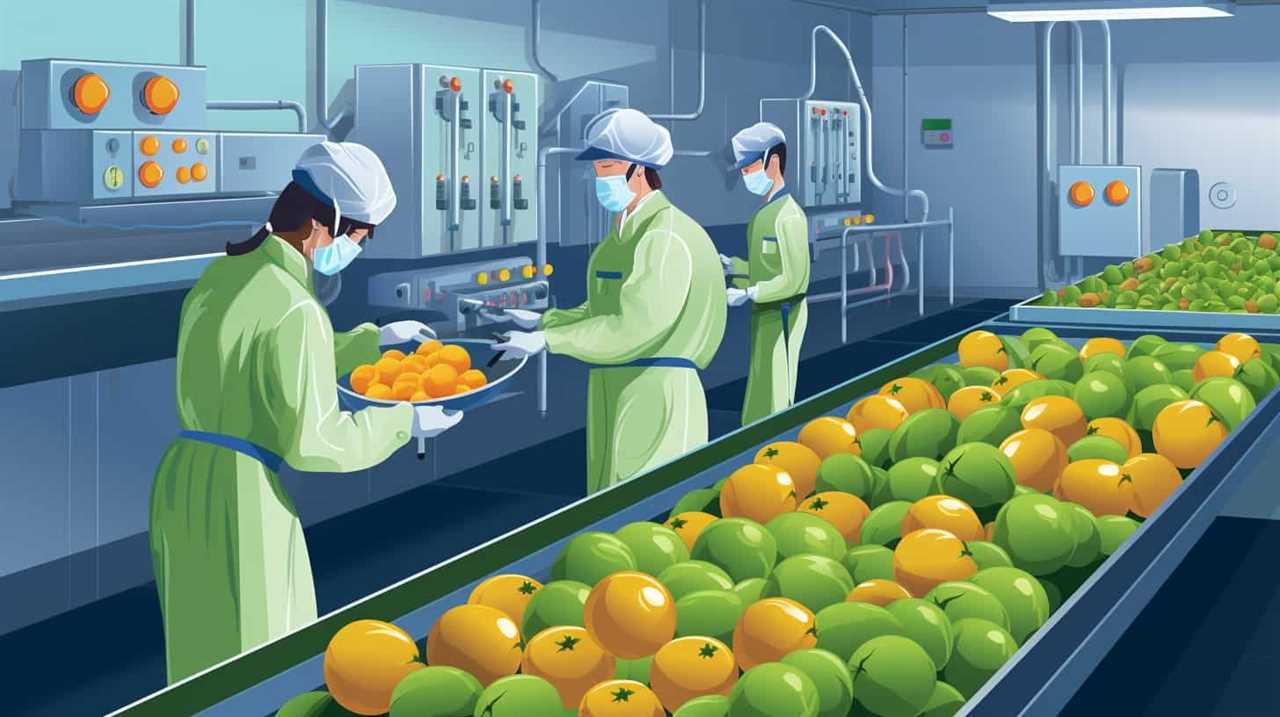
Waste Reduction Techniques
How can juice bag-in-box solutions help reduce waste in a sustainable manner?
Juice bag-in-box solutions offer a range of waste reduction techniques that align with waste management strategies and circular economy approaches. Here are two ways in which these eco-friendly solutions can make a positive impact:
- Minimal Packaging Waste: Juice bag-in-box solutions use less packaging material compared to traditional juice packaging. The bags are designed to be lightweight and compact, reducing the amount of waste generated during production and transportation.
- Extended Shelf Life: These solutions utilize airtight bags that prevent air and light from reaching the juice, thereby extending its shelf life without the need for preservatives. This helps to reduce food waste as the juice remains fresh for a longer period, reducing the likelihood of it being discarded before consumption.
Environmental Impact Assessment
One important aspect to consider when evaluating eco-friendly juice bag-in-box solutions is their environmental impact. Conducting an environmental impact assessment allows us to understand the potential effects of these solutions on the environment and make informed decisions. To illustrate the impact, let’s examine a comparison between traditional juice packaging and bag-in-box solutions:
| Environmental Impact | Traditional Juice Packaging | Bag-in-Box Solutions |
|---|---|---|
| Waste Generation | High | Low |
| Energy Consumption | High | Low |
| Greenhouse Gas Emissions | High | Low |
As we can see, bag-in-box solutions have a significantly lower environmental impact compared to traditional juice packaging. With proper waste management strategies in place, such as recycling and composting, we can further reduce the impact. By choosing eco-friendly juice bag-in-box solutions, we can contribute to a more sustainable and environmentally conscious future.
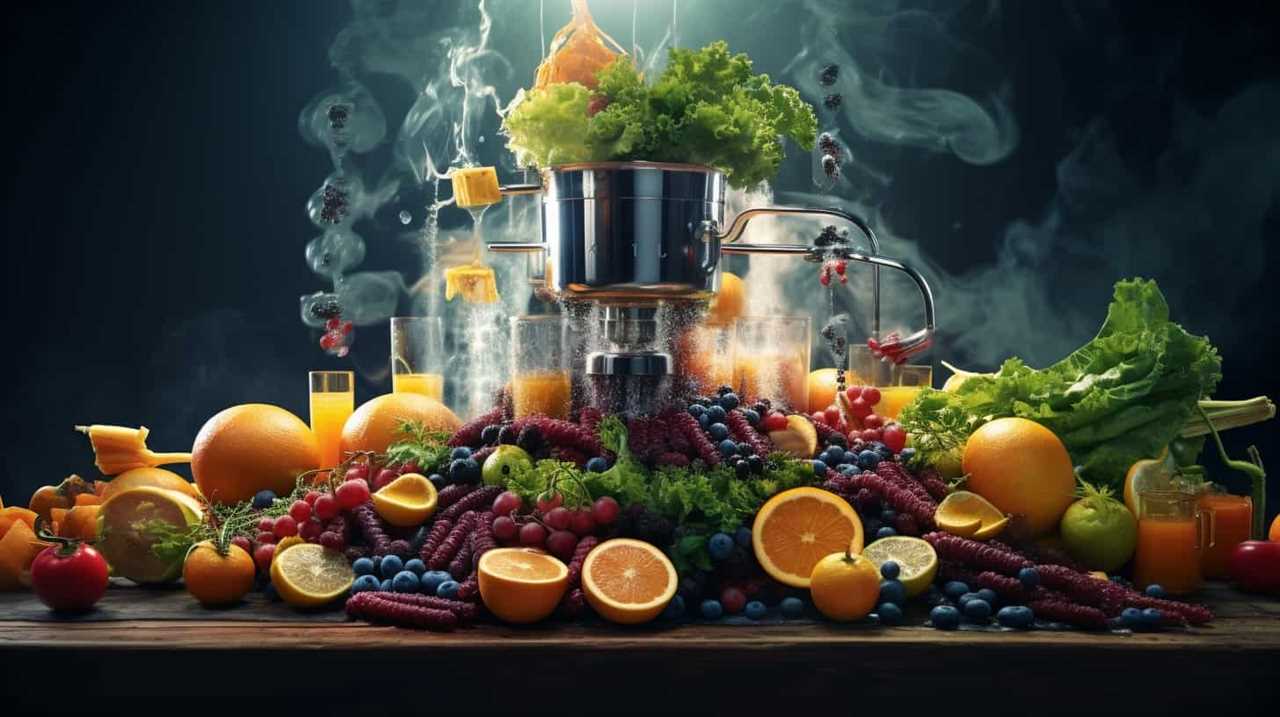
Innovative Juice Can Packaging
We have discovered a new and sustainable solution for juice packaging and storage by utilizing innovative juice can packaging. This approach involves the use of innovative juice can designs and sustainable juice can manufacturing techniques.
Here are two key benefits of this packaging solution:
- Improved shelf life: The innovative designs of these juice cans are specifically engineered to provide optimal protection against light, air, and moisture. This helps to extend the shelf life of the juice, ensuring that it remains fresh and flavorful for a longer period of time.
- Reduced environmental impact: The sustainable manufacturing techniques used in producing these juice cans prioritize the use of recycled materials and minimize waste generation. Additionally, the cans are designed to be easily recyclable, further reducing their environmental footprint.
Minimalist Juice Storage Solutions
To maximize efficiency and minimize clutter, we opted for minimalist juice storage solutions. When it comes to juice storage organization, it is important to find containers that not only save space but also keep the juice fresh and easily accessible. We have curated a selection of space-saving juice containers that will help you streamline your juice storage system. Take a look at the table below for some options:
| Container Type | Features |
|---|---|
| Stackable Bottles | Easy to store and retrieve |
| Vertical Dispensers | Compact design |
| Multi-tiered Racks | Utilize vertical space |
These containers and storage solutions will not only help you keep your juice collection organized, but also free up valuable counter and fridge space. With these minimalist juice storage solutions, you can create a neat and efficient system that allows for easy access and prevents wastage. Now, let’s move on to the next section about sustainable juice dispensers, where we will explore eco-friendly options for serving juice.
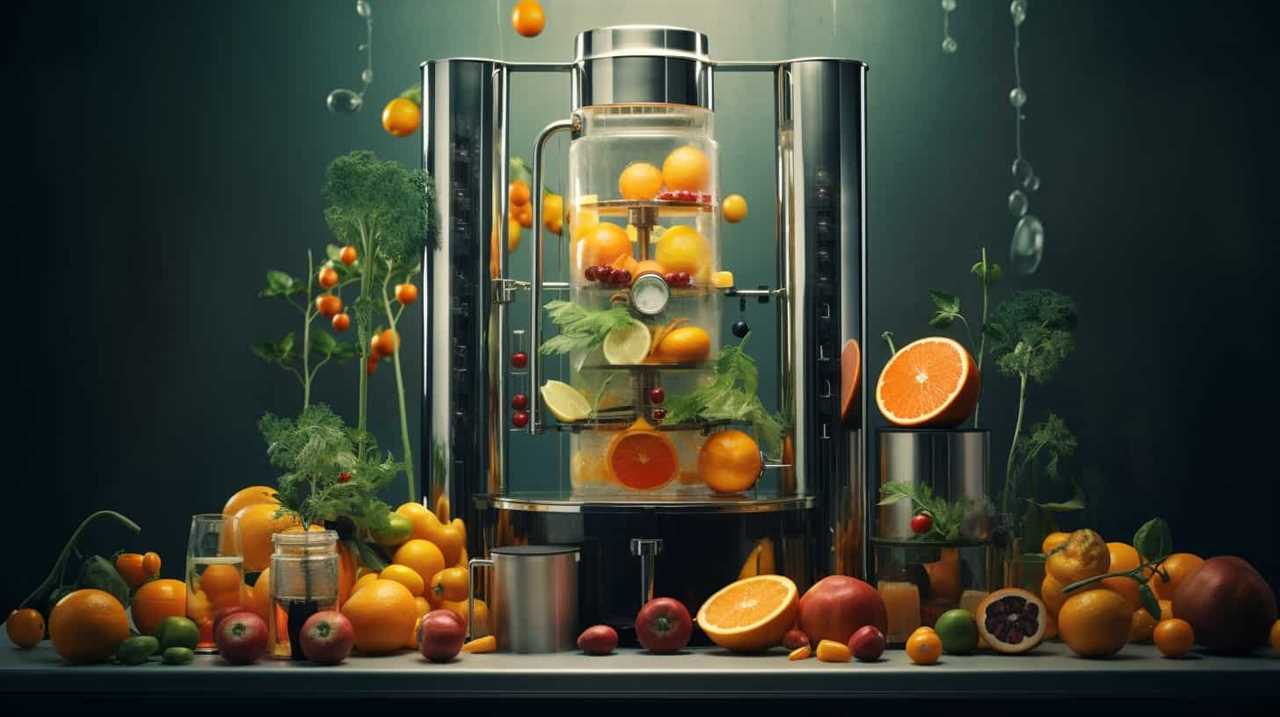
Sustainable Juice Dispensers
Moving on from the previous section on minimalist juice storage solutions, let’s now explore sustainable juice dispensers and their impact on reducing waste and promoting eco-friendly practices.
Sustainable juice taps offer an innovative solution to the problem of single-use plastic bottles and containers. Here are two key benefits of sustainable juice dispensers:
- Zero waste juice dispensing: Sustainable juice taps allow for the dispensing of juice directly into reusable containers, eliminating the need for disposable packaging. By reducing the amount of waste generated, these dispensers contribute to a more sustainable and environmentally friendly approach to juice consumption.
- Cost-effective and efficient: Sustainable juice dispensers not only help reduce waste but also prove to be cost-effective and efficient for businesses. By eliminating the need for individual packaging, businesses can save on packaging costs and reduce their carbon footprint.
Eco-Conscious Juice Bottle Caps
Continuing our exploration of sustainable juice packaging and storage, let’s now turn our attention to the topic of eco-conscious juice bottle caps. When it comes to reducing waste and promoting environmental responsibility, it is important to consider sustainable closure alternatives for juice bottles. Biodegradable cap options are an excellent choice for eco-conscious consumers who want to minimize their impact on the planet.
To provide a comprehensive overview, let’s examine a table comparing different biodegradable cap options and their key features:

| Biodegradable Cap Options | Key Features |
|---|---|
| PLA Caps | Made from plant-based materials such as cornstarch or sugarcane, fully compostable |
| Cork Caps | Derived from the bark of cork oak trees, renewable and recyclable |
| Bioplastics Caps | Made from renewable resources like bio-based polymers, biodegradable in certain conditions |
Ethical Juice Packaging Materials
Let’s now delve into the topic of ethical juice packaging materials, as we explore sustainable options to further reduce waste and promote environmental responsibility. As consumers become more conscious of the impact of their choices, it’s crucial for juice companies to embrace packaging materials that align with these values.
Here are two sustainable options to consider:
- Biodegradable juice straws: Traditional plastic straws contribute to the global plastic waste crisis. By switching to biodegradable alternatives made from materials like paper or plant-based plastics, juice companies can reduce their ecological footprint and provide customers with guilt-free sipping experiences.
- Sustainable juice labels: Labels are an essential part of juice packaging, but they often end up in landfills due to their non-recyclable nature. Using sustainable labels made from recycled materials or compostable paper can significantly reduce waste and support the circular economy.
By adopting these ethical packaging materials, juice companies can demonstrate their commitment to environmental stewardship while providing customers with eco-friendly choices.
Now, let’s explore eco-friendly juice packaging accessories that further enhance sustainability efforts.
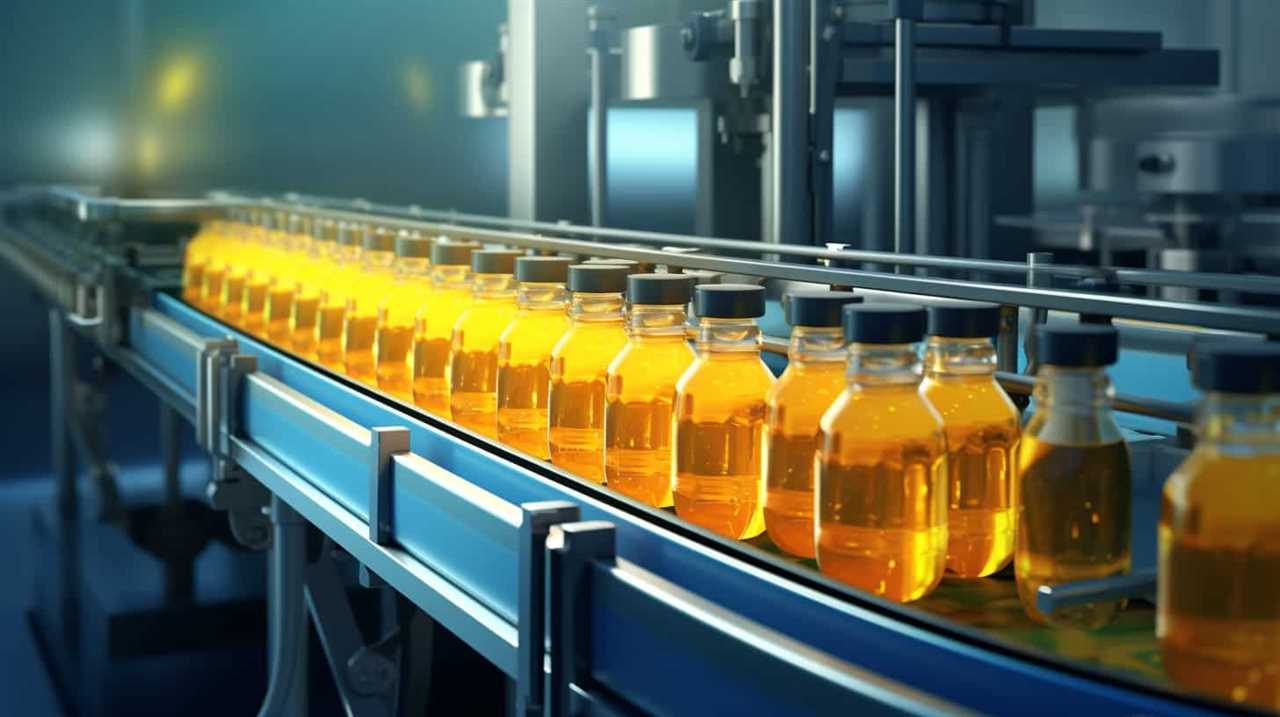
Eco-Friendly Juice Packaging Accessories
Now, we can explore how to enhance our sustainability efforts by incorporating eco-friendly accessories into our juice packaging. One way to reduce plastic waste is to switch to biodegradable straw alternatives. These straws are typically made from materials like paper, bamboo, or even edible materials like wheat or rice. By using biodegradable straws instead of plastic ones, we can significantly reduce our environmental impact. Additionally, we can also focus on using sustainable juice bottle labels. These labels can be made from materials like recycled paper or plant-based materials, reducing the use of plastic and promoting eco-friendly practices. By making these simple changes to our juice packaging accessories, we can contribute to a more sustainable future and serve our customers with a clear conscience.
| Biodegradable Straw Alternatives | Sustainable Juice Bottle Labels |
|---|---|
| Paper straws | Recycled paper labels |
| Bamboo straws | Plant-based labels |
| Wheat straws | |
| Rice straws | |
| Edible straws |
Frequently Asked Questions
How Long Does It Take for Biodegradable Juice Bottles to Break Down in a Landfill?
Biodegradable juice bottles take approximately [time frame] to break down in a landfill. This is important because it highlights the effectiveness of these bottles in reducing the environmental impact of non-biodegradable alternatives.
Are Recyclable Juice Cartons Accepted in All Recycling Programs?
Recyclable juice cartons may not be accepted in all recycling programs due to recycling contamination. However, there are alternative packaging options like reusable glass bottles or biodegradable pouches that can help reduce environmental impact.
Can Compostable Juice Pouches Be Used for Hot Liquids?
Yes, compostable juice pouches can be used for hot liquids. They are a sustainable alternative to plastic juice bottles. Compostable hot cups are also available, providing more eco-friendly options for packaging and serving beverages.

What Is the Average Lifespan of Sustainable Glass Juice Containers?
On average, glass juice containers have a lifespan of 20 years. However, this can be extended with proper care and recycling programs. For example, in our community, glass containers are recycled into new products, reducing waste and promoting sustainability.
Are Reusable Juice Jars Dishwasher Safe?
Reusable juice jars offer the convenience of dishwasher safety, allowing for easy cleaning and reuse. This not only reduces waste but also provides long-term cost savings and environmental benefits.
Conclusion
In conclusion, there are numerous sustainable solutions for juice packaging and storage that can significantly reduce our environmental impact.
From biodegradable bottles to reusable jars and compostable pouches, these options provide a more ethical and eco-friendly alternative to traditional packaging materials.
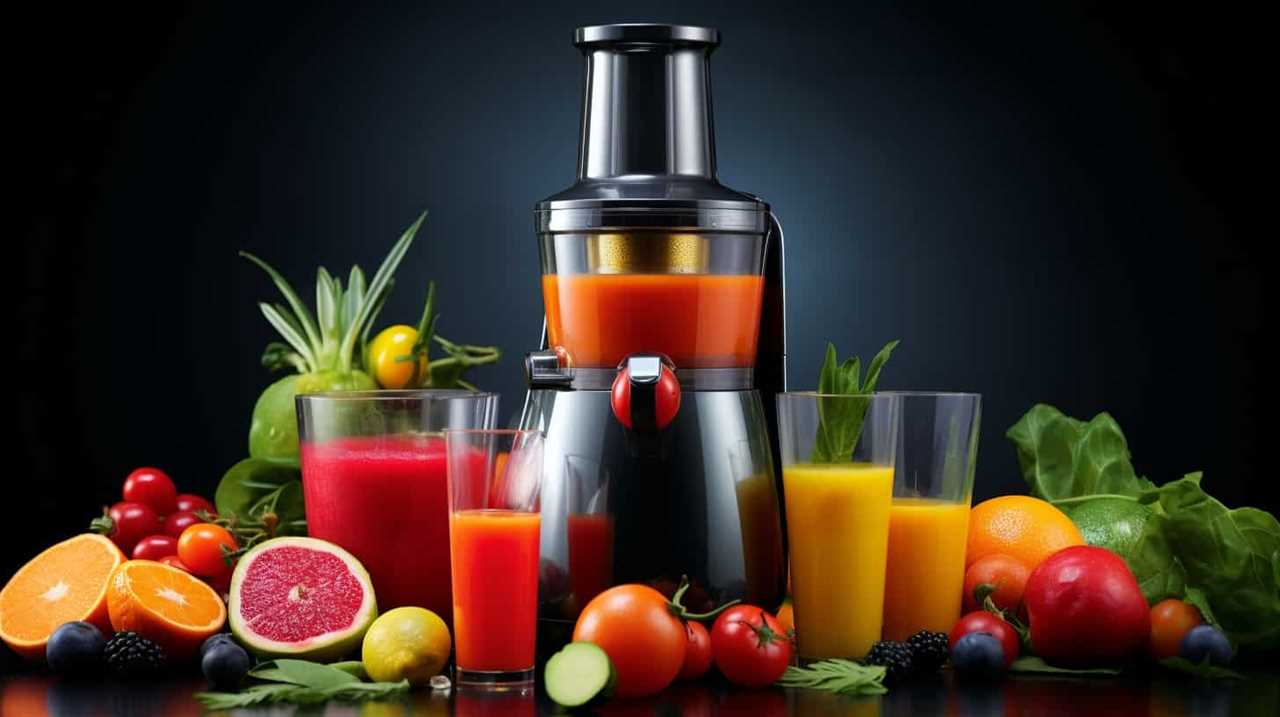
By adopting these practices, we can contribute to a healthier planet and ensure a more sustainable future for generations to come.
Let’s make conscious choices and embrace these innovative solutions for a greener tomorrow.
Susannah expertise lies in researching and compiling evidence-based content on juicing, nutrition, and overall health. She is committed to ensuring that The Juicery World offers accurate, up-to-date, and trustworthy information to empower readers to take control of their health. Susannah’s goal is to inspire individuals to embrace juicing as a way to nourish their bodies and live their best lives.
Juice Manufacturing Process
Why Opt for Top-Notch Materials in Beverage Packaging?

We select only the finest materials for our beverage packaging because they form the basis of our commitment to excellence.
By opting for top-notch materials, we ensure that our packaging is strong, reliable, and visually appealing.
This article explores the importance of quality materials, the benefits of using top-notch packaging, and the factors to consider when selecting them.
We will also discuss the top materials for juice packaging and sustainable options for beverage packaging.
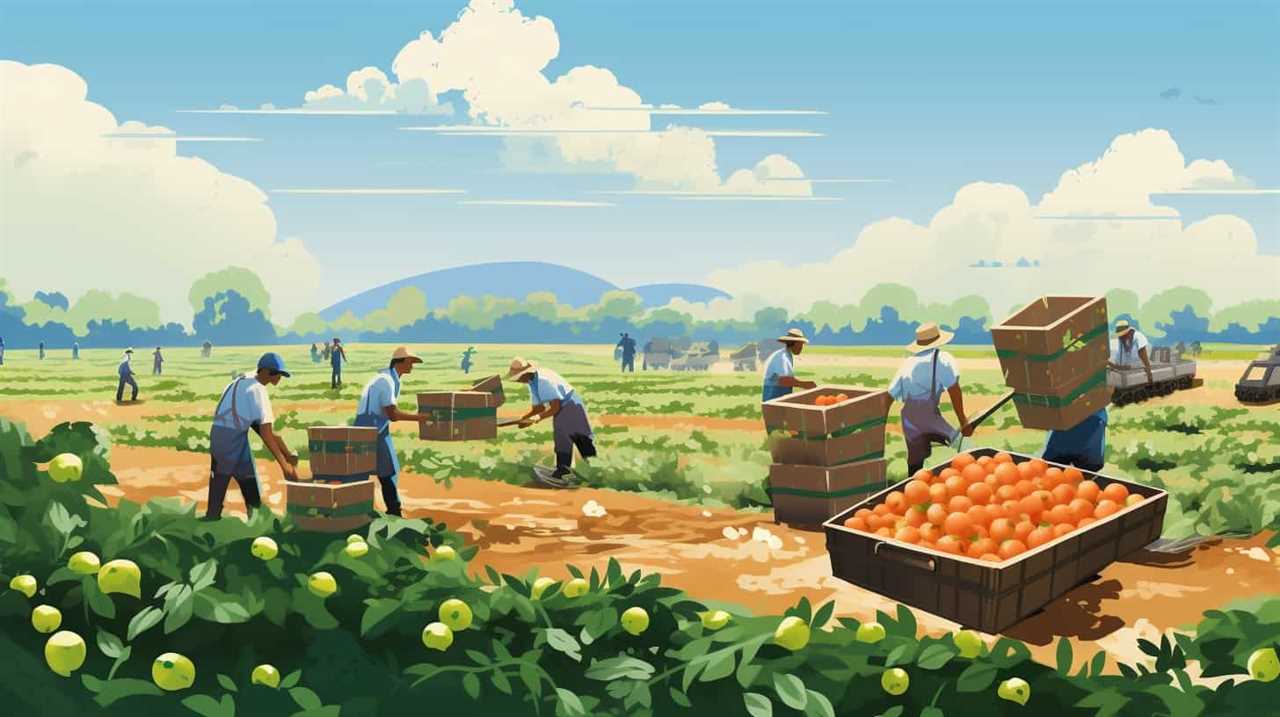
Join us as we elevate the art of serving others through exceptional packaging.
Key Takeaways
- Quality materials ensure durability and safety of packaging.
- Investing in top-notch materials reduces the risk of damage or leaks during transportation and storage.
- Enhanced product protection against light, moisture, and oxygen.
- Premium packaging materials create a positive brand image.
Importance of Quality Materials
Quality materials are essential for ensuring the durability and safety of beverage packaging. By using high-quality materials, companies can achieve cost efficiency and customer satisfaction. Investing in top-notch materials may seem expensive at first, but it proves to be cost-efficient in the long run. Quality materials ensure that the packaging can withstand the rigors of transportation and storage, reducing the risk of damage or leaks. This not only minimizes the need for costly replacements but also prevents potential customer dissatisfaction due to faulty packaging.
Benefits of Using Top-Notch Packaging
When it comes to beverage packaging, we greatly benefit from using top-notch materials. The advantages of using high-quality packaging materials are numerous and can greatly impact the success of a beverage product.
Here are three key advantages:
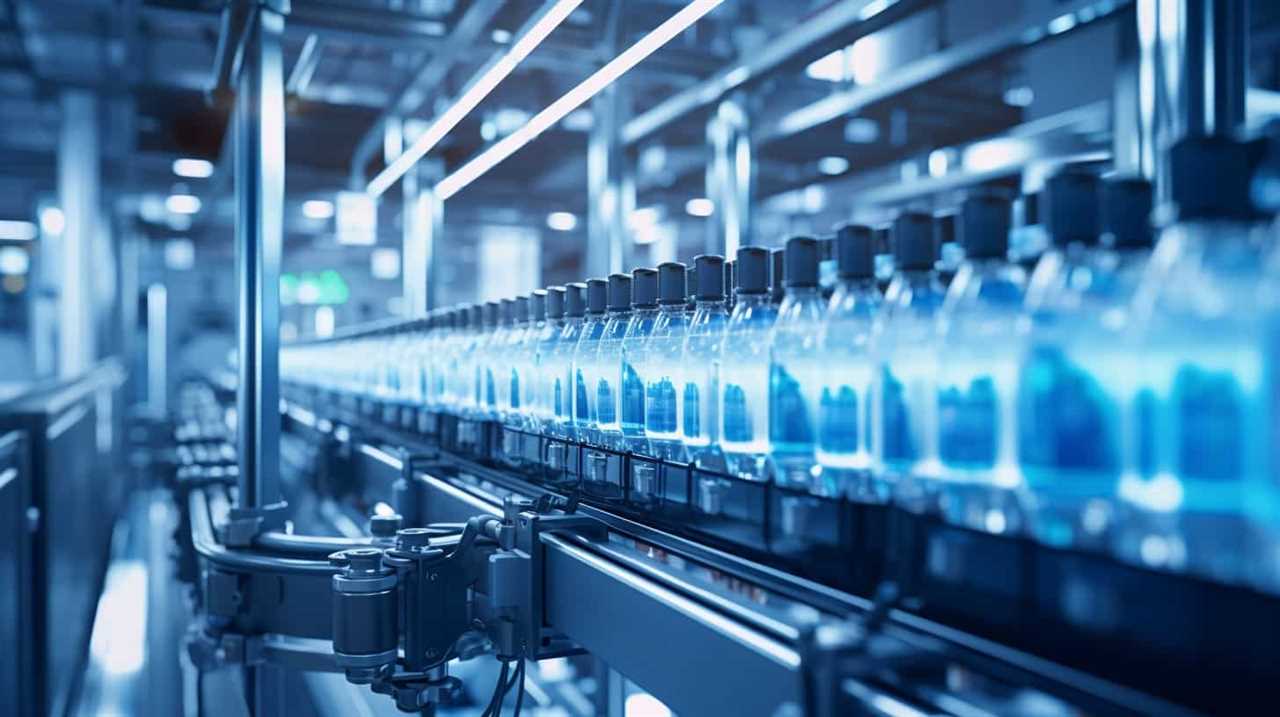
- Enhanced product protection: Top-notch materials provide superior protection against external factors such as light, moisture, and oxygen. This helps to maintain the freshness and quality of the beverage, ensuring it reaches the consumer in the best possible condition.
- Increased shelf life: High-quality packaging materials can extend the shelf life of beverages by preventing spoilage and deterioration. This not only reduces waste but also allows for wider distribution and longer storage periods.
- Enhanced brand image: Premium packaging materials convey a sense of quality and value to consumers. By investing in top-notch materials, beverage brands can create a positive impression and differentiate themselves from competitors, ultimately leading to increased customer loyalty and sales.
Factors to Consider in Material Selection
To ensure optimal beverage packaging, we must carefully consider various factors in material selection. When choosing the right materials for beverage packaging, cost considerations and durability factors are key considerations.
In terms of cost, it is important to strike a balance between the price of the materials and the value they provide. While it may be tempting to opt for cheaper materials to reduce costs, it is crucial to evaluate the long-term impact on the product’s quality and customer satisfaction. Investing in top-notch materials that offer durability can result in fewer product failures, reduced maintenance, and improved customer experience.
To help guide the material selection process, consider the following factors:
| Cost Considerations | Durability Factors |
|---|---|
| Material Price | Strength |
| Production Costs | Resistance |
| Maintenance Costs | Shelf Life |
Top Materials for Juice Packaging
We recommend using high-quality materials for juice packaging to ensure optimal product protection and customer satisfaction. When it comes to juice packaging, there are several top materials that offer both sustainability and innovative designs.
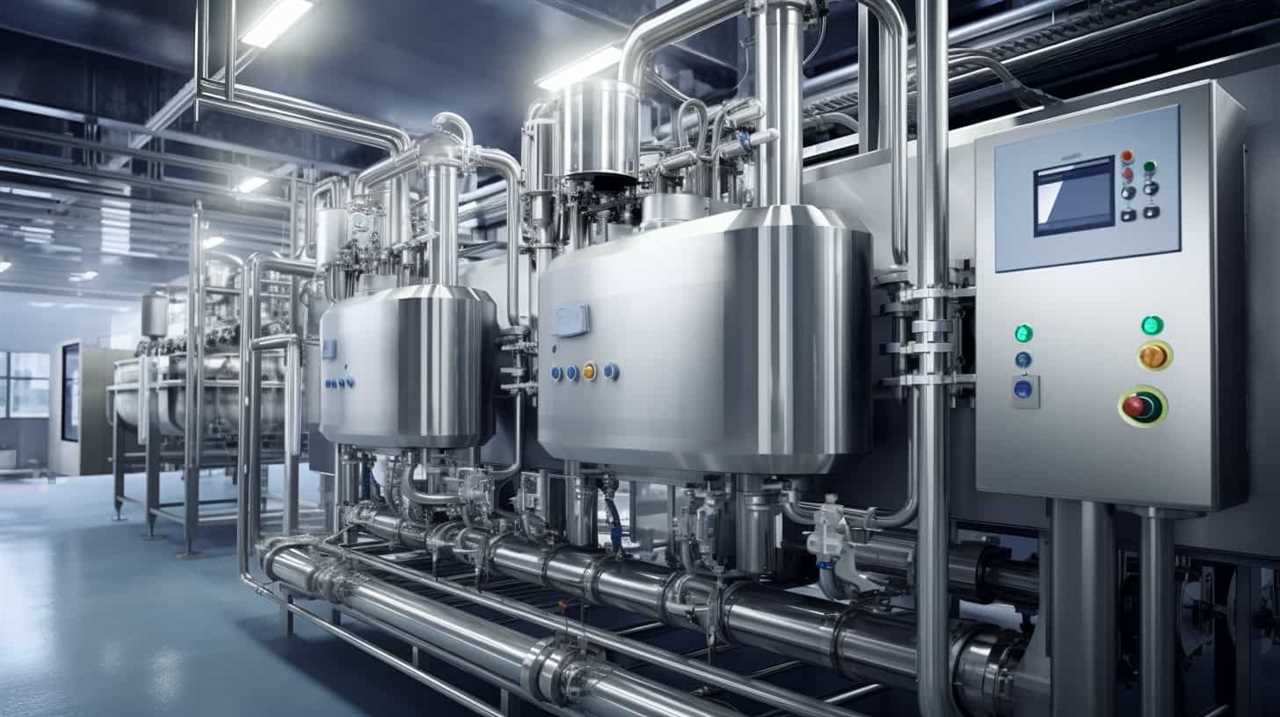
- Plant-based bioplastics: These materials are derived from renewable resources, such as corn or sugarcane, and have a lower carbon footprint compared to traditional plastics. They’re also compostable, reducing waste and environmental impact.
- Recycled paperboard: Made from recycled paper fibers, this material isn’t only eco-friendly but also provides excellent structural integrity and moisture resistance. It can be easily customized with vibrant designs and graphics, enhancing the shelf appeal of the juice products.
- Glass: Although glass isn’t as lightweight as other materials, it’s 100% recyclable and preserves the taste and freshness of juices. Glass bottles can be reused or recycled, making them a sustainable choice for juice packaging.
Sustainable Options for Beverage Packaging
For sustainable beverage packaging, we prioritize the use of environmentally friendly materials. In today’s world where consumers are increasingly conscious about the impact of their choices on the environment, it is imperative for beverage companies to offer recyclable alternatives and eco-friendly packaging options. By choosing materials that can be easily recycled, we can minimize waste and contribute to a circular economy.
One popular sustainable option is the use of plant-based plastics, such as PLA (polylactic acid), which are derived from renewable resources like cornstarch or sugarcane. These materials are biodegradable and reduce the reliance on fossil fuels. Additionally, paper-based packaging made from responsibly sourced, certified sustainable forest products is another eco-friendly choice. These materials can be recycled multiple times and have lower carbon footprints compared to traditional packaging materials.
To further illustrate the sustainable options available for beverage packaging, here is a table showcasing three examples:
| Sustainable Material | Features | Benefits |
|---|---|---|
| Plant-based plastics | Biodegradable, derived from renewable resources | Reduces reliance on fossil fuels |
| Paper-based packaging | Recyclable, sourced from sustainable forests | Lowers carbon footprints |
| Glass bottles | Infinitely recyclable, durable | Reduces waste and energy consumption |
Frequently Asked Questions
What Are the Potential Risks or Drawbacks of Using Low-Quality Materials in Beverage Packaging?
Using low-quality materials in beverage packaging can lead to potential risks and drawbacks. It can negatively impact product quality, causing customer dissatisfaction. Opting for top-notch materials ensures a better overall experience for consumers.
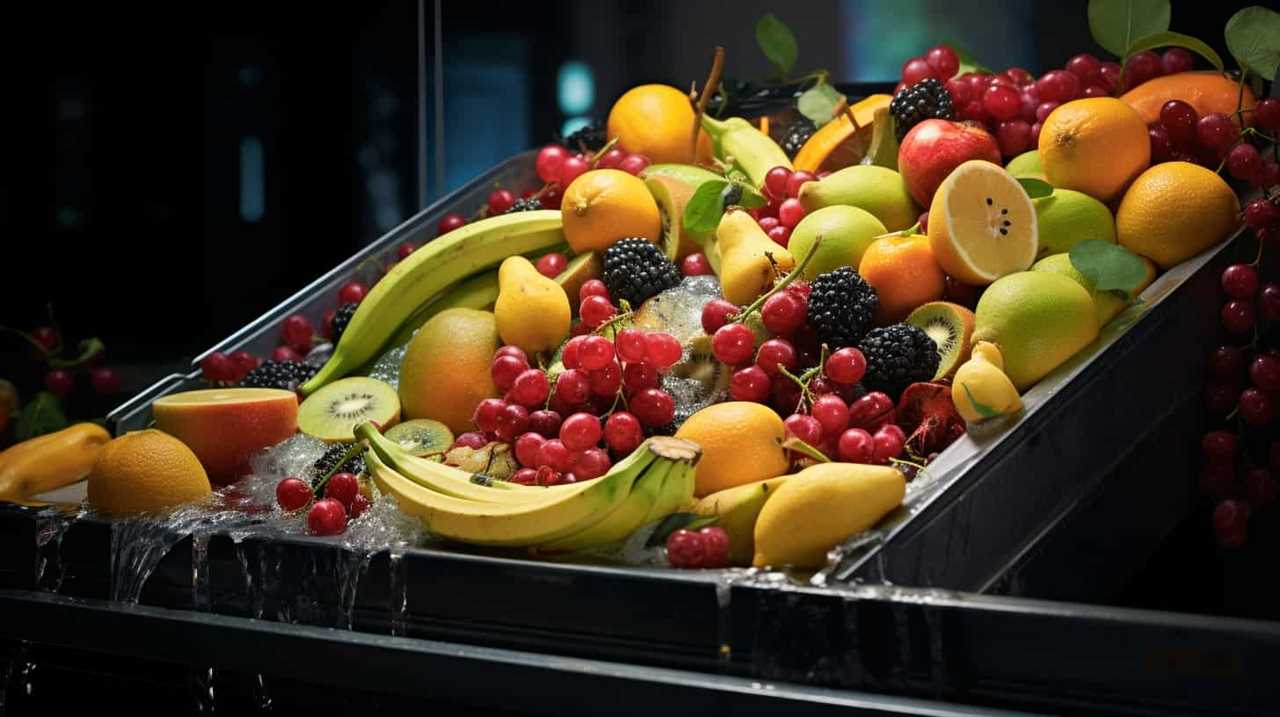
How Can Using Top-Notch Packaging Materials Enhance the Shelf Life of Beverages?
Using top-notch packaging materials enhances freshness and ensures product safety, ultimately extending the shelf life of beverages. By incorporating advanced technologies and superior materials, we can guarantee the highest quality and satisfaction for our customers.
Are There Any Specific Regulations or Standards That Dictate the Use of High-Quality Materials in Beverage Packaging?
Regulations and standards exist to ensure the use of high-quality materials in beverage packaging. These guidelines aim to maintain product safety, quality, and integrity, which ultimately benefits both consumers and manufacturers.
What Are Some Innovative Materials That Are Being Utilized in the Beverage Packaging Industry?
Innovative materials are revolutionizing the beverage packaging industry. We are seeing sustainable solutions like biodegradable plastics, plant-based materials, and recyclable packaging gaining traction. These advancements ensure top-notch quality while minimizing environmental impact.
Can the Use of Sustainable Packaging Materials Have a Positive Impact on a Brand’s Image and Customer Perception?
Using sustainable packaging materials can greatly enhance a brand’s reputation and customer perception. Studies show that 70% of consumers are willing to pay more for products packaged in eco-friendly materials, highlighting the positive impact it can have on a brand’s image.
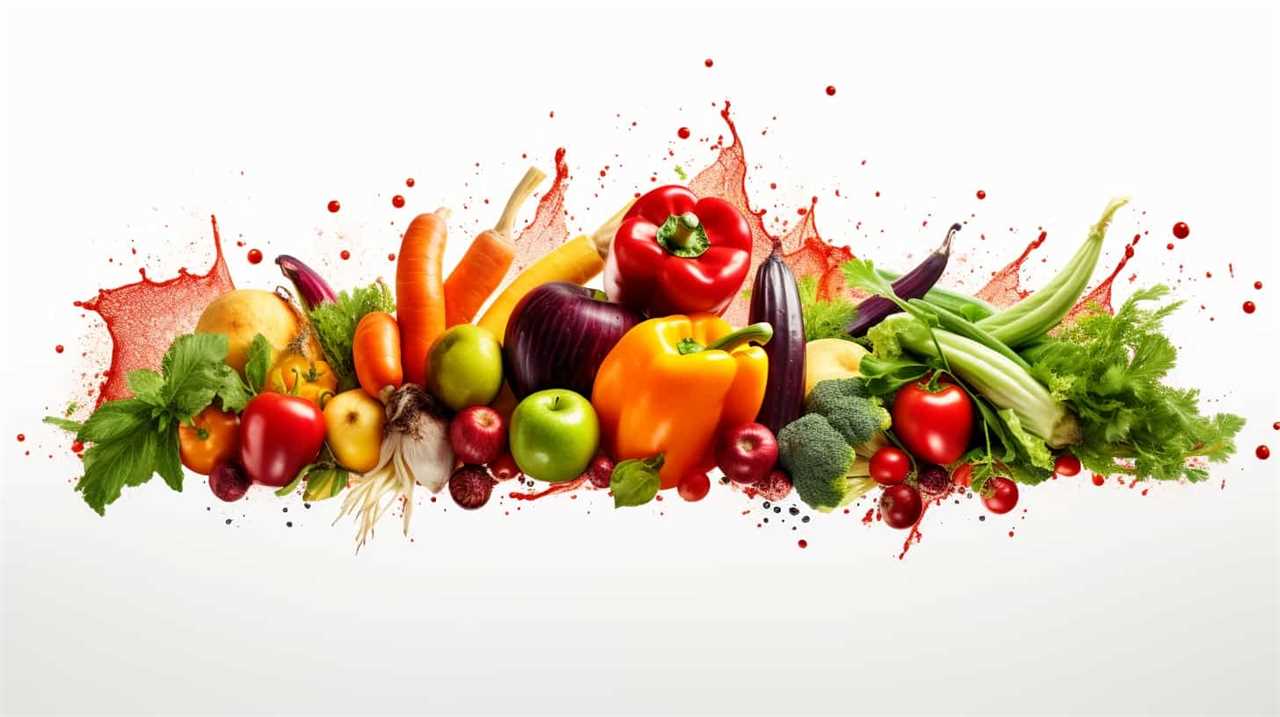
Conclusion
In conclusion, opting for top-notch materials in beverage packaging is crucial for ensuring product quality and customer satisfaction. Using high-quality materials offers numerous benefits, such as enhanced product protection, improved shelf life, and increased brand value.
Additionally, selecting the right materials for packaging is essential, considering factors like durability, compatibility, and sustainability. Interestingly, a study found that 85% of consumers are willing to pay a premium for products packaged in sustainable materials, highlighting the growing importance of eco-friendly options in the beverage industry.
Susannah expertise lies in researching and compiling evidence-based content on juicing, nutrition, and overall health. She is committed to ensuring that The Juicery World offers accurate, up-to-date, and trustworthy information to empower readers to take control of their health. Susannah’s goal is to inspire individuals to embrace juicing as a way to nourish their bodies and live their best lives.
Juice Manufacturing Process
Why Is Proper Temperature Crucial for Beverage Storage?
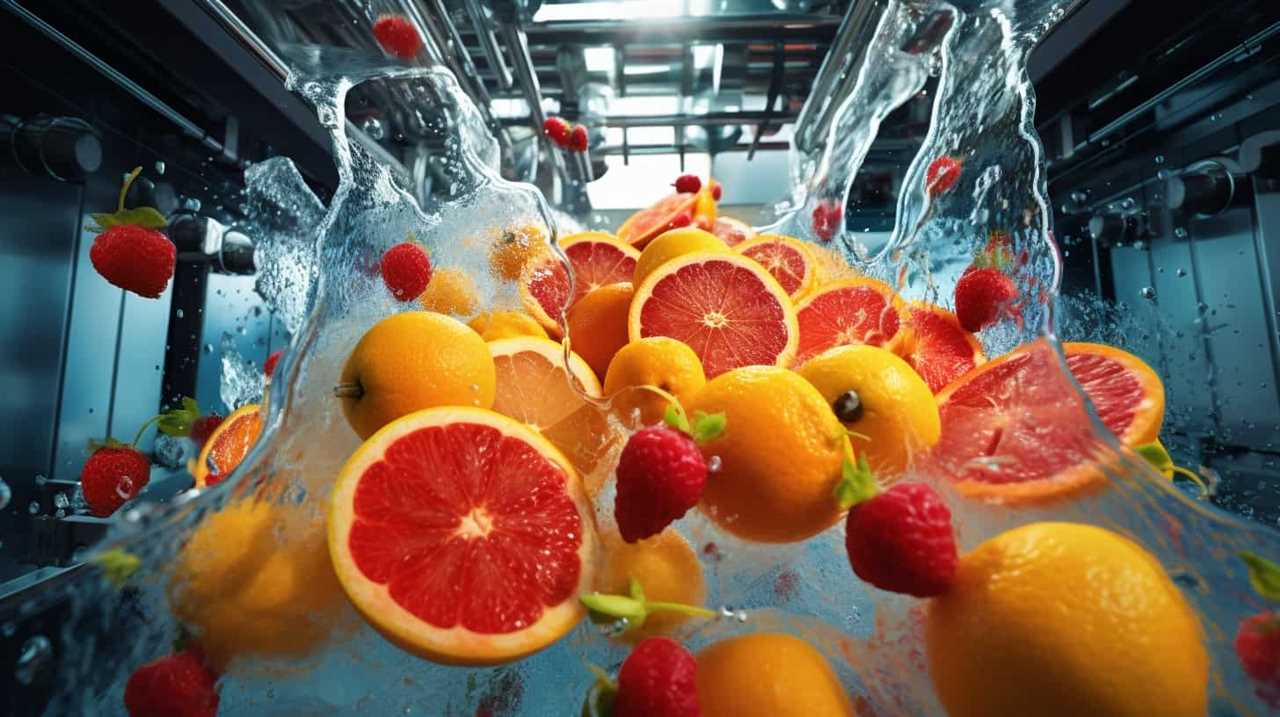
Temperature is the vital factor at the core of our mission to provide you with the ideal drink experience.
In this article, we delve into the importance of maintaining proper temperature for beverage storage. From the ideal range for juice storage to the impact on quality and prevention of spoilage, we explore the technicalities and best practices for temperature control.
Join us on this journey to discover why temperature is the key to unlocking the best flavors in your favorite beverages.
Key Takeaways
- The ideal temperature range for juice storage is between 32 and 40 degrees Fahrenheit to preserve its nutritional value, taste, and sensory characteristics.
- Temperature fluctuations can negatively impact enzymatic reactions in juice, leading to changes in taste, color, and nutritional value.
- Consistently maintaining the proper temperature for beverage storage is essential to prevent spoilage and ensure the safety and quality of the juice.
- Temperature monitoring, refrigeration systems, and regular maintenance are important methods for controlling and maintaining optimal temperature conditions for juice storage.
Ideal Temperature Range for Juice Storage
The ideal temperature range for juice storage is between 32 and 40 degrees Fahrenheit. Maintaining the proper temperature is crucial for preserving the quality, safety, and freshness of the juice.
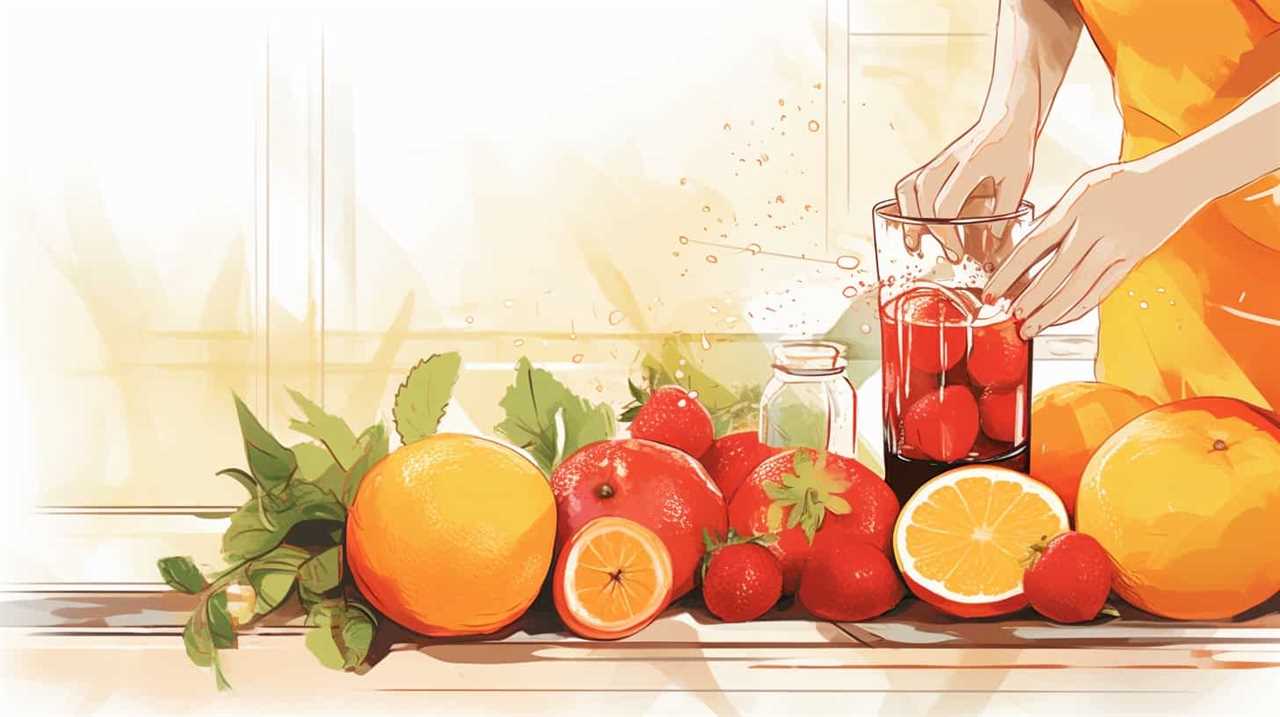
Juice storage requirements are directly influenced by temperature, as fluctuations can have significant effects on juice safety. Cold temperatures help inhibit the growth of bacteria and other microorganisms, reducing the risk of spoilage and potential health hazards.
Additionally, storing juice within the recommended temperature range helps preserve its nutritional value, taste, and overall sensory characteristics. Temperature control is especially important for establishments that prioritize serving others, as it ensures that customers receive a safe and enjoyable beverage experience.
Impact of Temperature on Juice Quality
Maintaining the proper temperature range for juice storage impacts the quality and freshness of the beverage. Temperature fluctuation can have a significant effect on the enzymatic reactions in juice, which can ultimately lead to changes in taste, color, and nutritional value.
Enzymes are responsible for various chemical reactions in juice, such as the breakdown of sugars and the conversion of certain compounds into aroma and flavor components. When exposed to temperature fluctuations, these enzymatic reactions can become unstable, leading to the degradation of important compounds and the development of off-flavors.
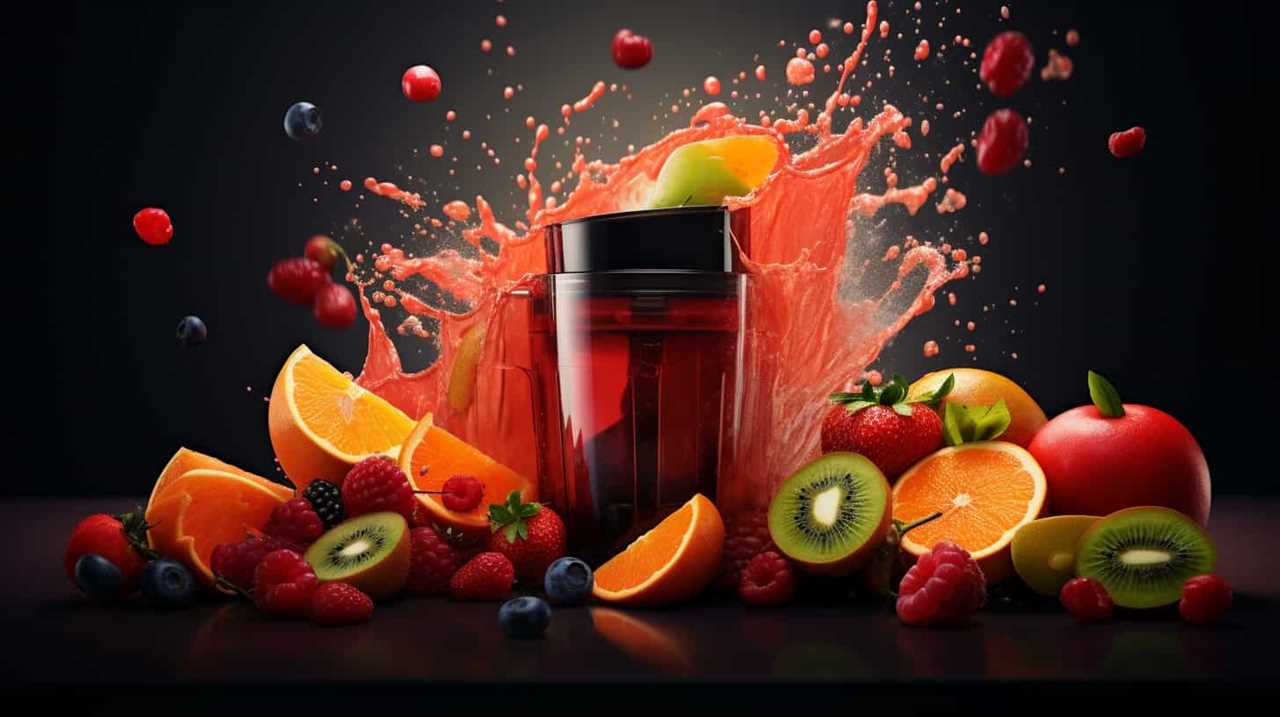
Additionally, high temperatures can accelerate the growth of microorganisms, further compromising the quality and safety of the juice. Therefore, it’s crucial to maintain a consistent temperature during juice storage to ensure optimal quality and minimize the risk of spoilage.
In the following section, we’ll explore the role of temperature in preventing spoilage and ensuring the longevity of juice products.
The Role of Temperature in Preventing Spoilage
To prevent spoilage, it’s essential to consistently maintain the proper temperature for beverage storage. Proper temperature control plays a crucial role in preventing contamination and inhibiting microbial growth, ensuring that beverages remain safe and of high quality.
When beverages are stored at temperatures outside of the recommended range, harmful bacteria and other microorganisms can multiply rapidly, leading to spoilage and potential health risks for consumers. By maintaining the appropriate temperature, we can effectively slow down the growth of these microorganisms, extending the shelf life of beverages and preserving their freshness.
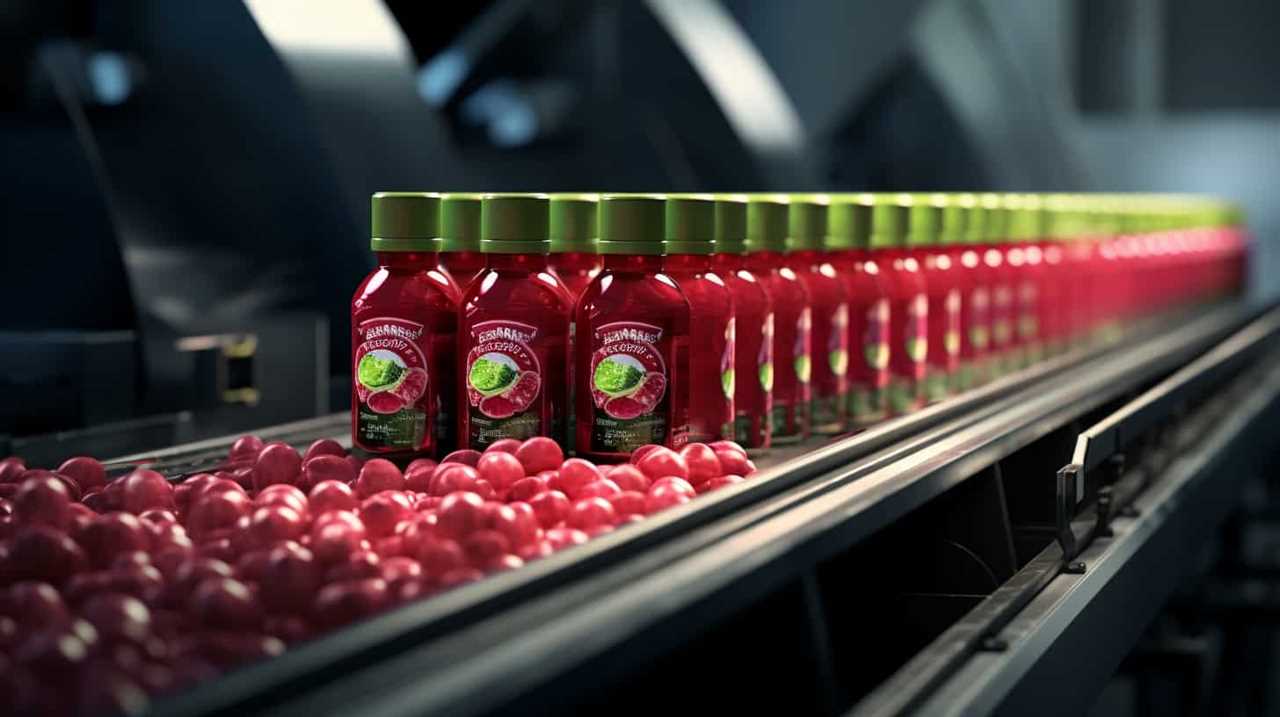
Temperature control methods for juice storage, which will be discussed in the subsequent section, are vital in achieving these goals and ensuring that beverages are served at their best quality.
Temperature Control Methods for Juice Storage
For juice storage, we rely on specific temperature control methods.
Temperature monitoring is essential to ensure that the juice is stored at the correct temperature to maintain its quality and extend its shelf life. One commonly used method is the use of temperature sensors or probes that are placed inside the storage area. These sensors continuously monitor the temperature and provide real-time data to ensure that it stays within the desired range.
Temperature regulation is achieved through the use of refrigeration systems or climate control devices, which adjust the temperature as needed to maintain optimal conditions. These systems are designed to provide a stable and controlled environment for juice storage, preventing temperature fluctuations that could lead to spoilage.
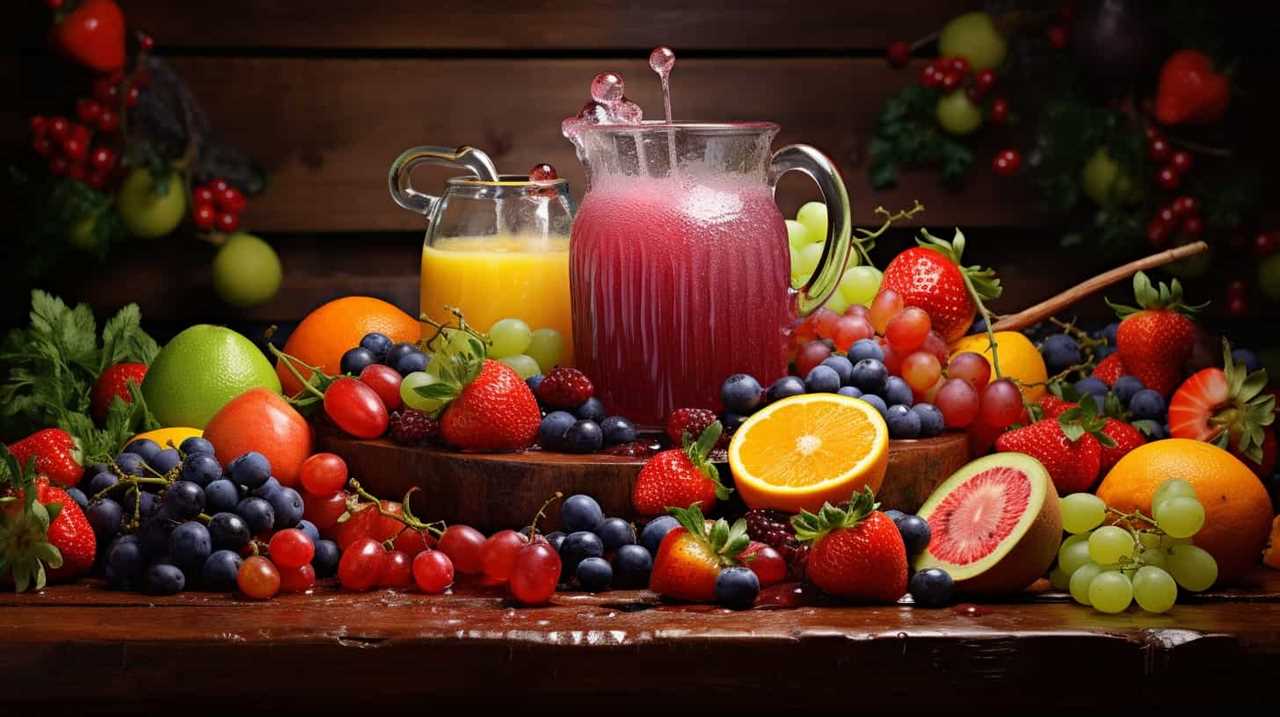
Best Practices for Maintaining Optimal Juice Temperature
We prioritize regular temperature checks to ensure that we maintain the optimal temperature for storing juice. Temperature regulation techniques play a vital role in preserving the freshness and quality of juice.
To maintain the ideal juice storage temperature, it’s essential to follow specific guidelines. Firstly, the recommended temperature for storing juice is between 32°F and 40°F (0°C and 4°C). This range prevents bacterial growth and helps retain the flavor and nutritional value of the juice.
Secondly, it’s crucial to store juice in a refrigerated environment to maintain its freshness. Additionally, regularly cleaning and maintaining the refrigeration units ensures proper temperature control.
Frequently Asked Questions
What Are the Potential Health Risks Associated With Storing Juice at Improper Temperatures?
Potential health risks of storing juice at improper temperatures include bacterial growth, spoilage, and the formation of harmful toxins. Proper temperature is crucial to prevent these risks and ensure the safety and quality of the beverage.
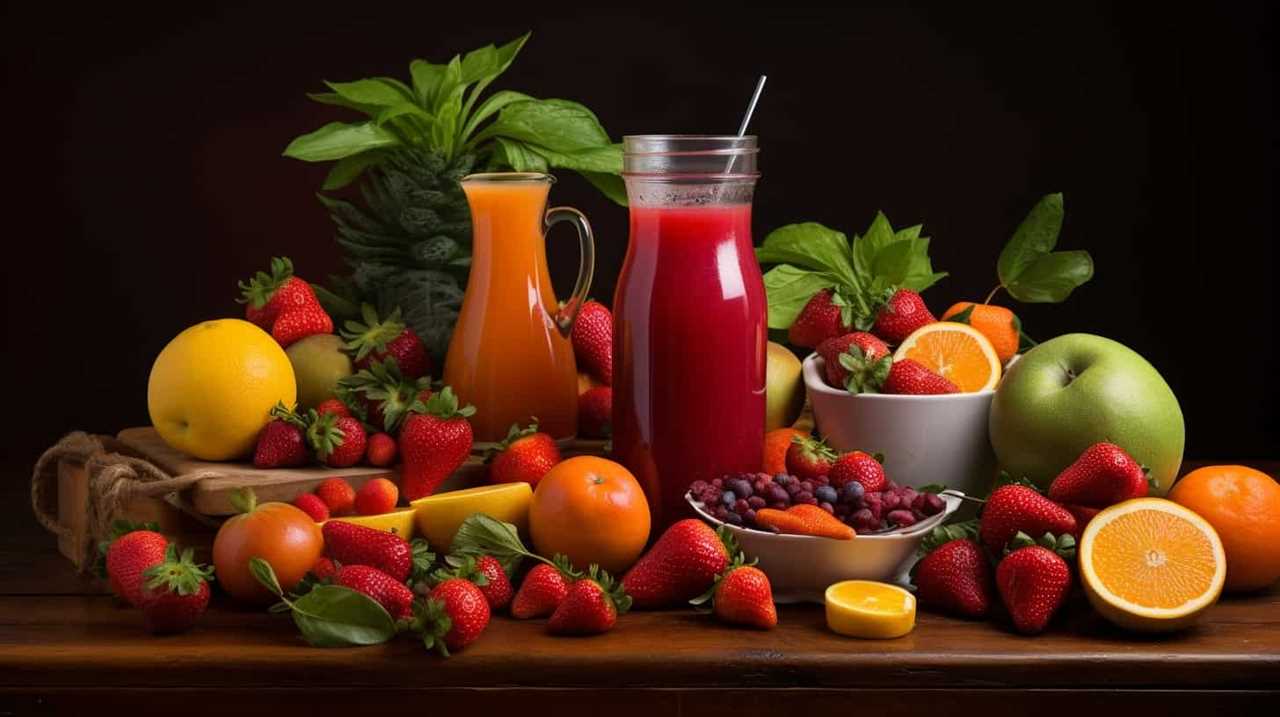
Are There Any Specific Types of Juice That Are More Sensitive to Temperature Changes?
Specific juice types exhibit varying degrees of temperature sensitivity, making proper temperature crucial for their storage. Understanding these variations allows us to serve others effectively by preserving the quality and taste of each beverage.
Can Fluctuations in Temperature Affect the Nutritional Content of Juice?
Fluctuations in temperature can have a significant impact on the nutritional content, flavor profile, and texture of juice. It is crucial to maintain proper temperature to preserve the quality of juice and ensure an enjoyable drinking experience.
How Does Temperature Impact the Shelf Life of Juice?
Temperature greatly affects the shelf life of juice. Fluctuations can break down nutrients and lead to spoilage. To ensure freshness, store juice at the recommended temperature. Proper temperature is crucial for preserving the quality and taste of fruit juices.
Are There Any Specific Storage Containers or Packaging Materials That Help Maintain Optimal Juice Temperature?
Insulated containers and cooling sleeves are specific storage solutions to maintain optimal beverage temperature. They prevent heat transfer and keep beverages cool for longer periods, ensuring freshness and taste.

Conclusion
In conclusion, maintaining the proper temperature for beverage storage is crucial for preserving the quality and preventing spoilage.
It may seem like a trivial detail, but failing to control temperature can lead to disastrous consequences. Just imagine the irony of investing in high-quality juice only to have it go bad due to negligence in temperature control.
So let’s not underestimate the impact of temperature and ensure we follow the best practices to keep our beverages at their optimal temperature.
Susannah expertise lies in researching and compiling evidence-based content on juicing, nutrition, and overall health. She is committed to ensuring that The Juicery World offers accurate, up-to-date, and trustworthy information to empower readers to take control of their health. Susannah’s goal is to inspire individuals to embrace juicing as a way to nourish their bodies and live their best lives.
Juice Manufacturing Process
Why Does Packaging Affect Shelf Life of Beverages?

The foundation of every drink is its packaging, serving as a protector of freshness and taste.
We, the curious minds, delve into the realm of packaging to uncover its impact on the shelf life of our beloved beverages.
Through our analytical lenses, we explore the types of juice packaging materials, the influence of oxygen and light, the role of temperature, and the importance of proper sealing techniques.
Join us on this journey towards serving you the knowledge you seek.

Key Takeaways
- Packaging materials with low oxygen permeability can extend the shelf life of beverages by reducing oxygen exposure and preventing chemical reactions that degrade quality and taste.
- Light exposure can lead to photooxidation and degradation of sensory and nutritional properties in beverages. Proper packaging materials should provide adequate light protection to minimize these effects.
- Consistent temperature control is crucial for preventing microbial growth and spoilage. Proper cold chain management and heat treatment techniques like pasteurization help preserve freshness and nutritional value.
- Proper sealing and packaging techniques are essential for preserving the integrity and freshness of beverages. Effective packaging techniques protect against external elements such as light exposure, flavor degradation, and nutrient loss.
Types of Juice Packaging Materials
When considering the shelf life of beverages, it’s important to explore the different types of juice packaging materials that can significantly impact their overall quality and longevity.
One key aspect to consider is the use of recyclable options, which not only aligns with sustainability goals but also ensures that the packaging material can be reused or repurposed, reducing waste.
Additionally, the cost effectiveness of packaging materials is a crucial factor that affects the shelf life of beverages. By opting for cost-effective materials, beverage manufacturers can reduce their production costs and pass on the savings to consumers.
It’s vital to select packaging materials that strike a balance between quality, longevity, recyclability, and cost effectiveness to ensure that beverages remain fresh and appealing for an extended period.
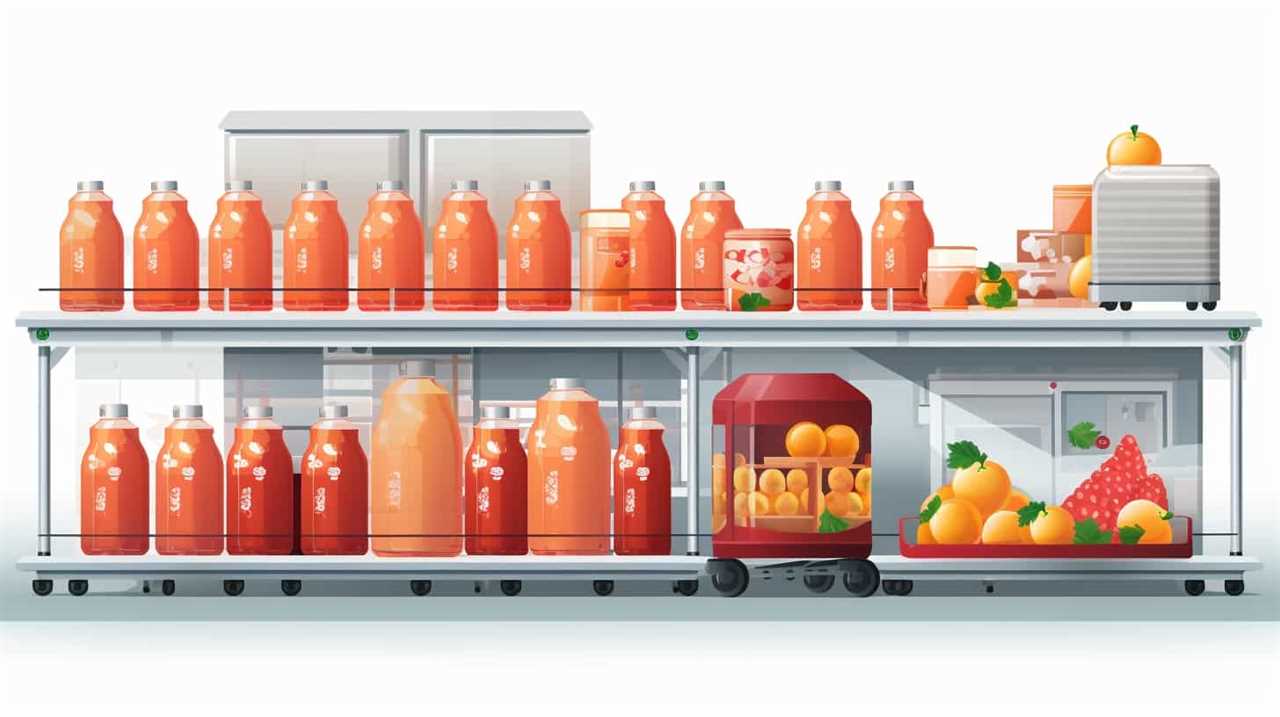
Impact of Oxygen Exposure on Juice Shelf Life
To further explore how packaging affects the shelf life of beverages, let’s now delve into the impact of oxygen exposure on the longevity of juice.
Oxygen absorption in juice can lead to the oxidation process, which can significantly reduce its shelf life. Here are three key points to consider:
- Oxygen absorption: When juice comes into contact with oxygen, it can lead to chemical reactions that degrade its quality and taste.
- Oxidation process: Oxygen reacts with the natural compounds present in juice, causing them to break down and undergo oxidation. This can result in off-flavors, discoloration, and nutrient loss.
- Shelf life: The rate at which oxygen permeates the packaging material and enters the juice determines its shelf life. Packaging materials with low oxygen permeability can help minimize oxygen exposure and extend the juice’s shelf life.
Understanding the impact of oxygen exposure on juice shelf life is crucial for ensuring that consumers are served with fresh and high-quality beverages.
Influence of Light on Juice Quality and Shelf Life
Light exposure plays a significant role in determining the quality and shelf life of juice. When juice is exposed to light, it undergoes a process called photooxidation, which leads to the degradation of its sensory and nutritional properties. This is primarily due to the interaction between the light and the juice’s components, such as vitamins, pigments, and antioxidants.
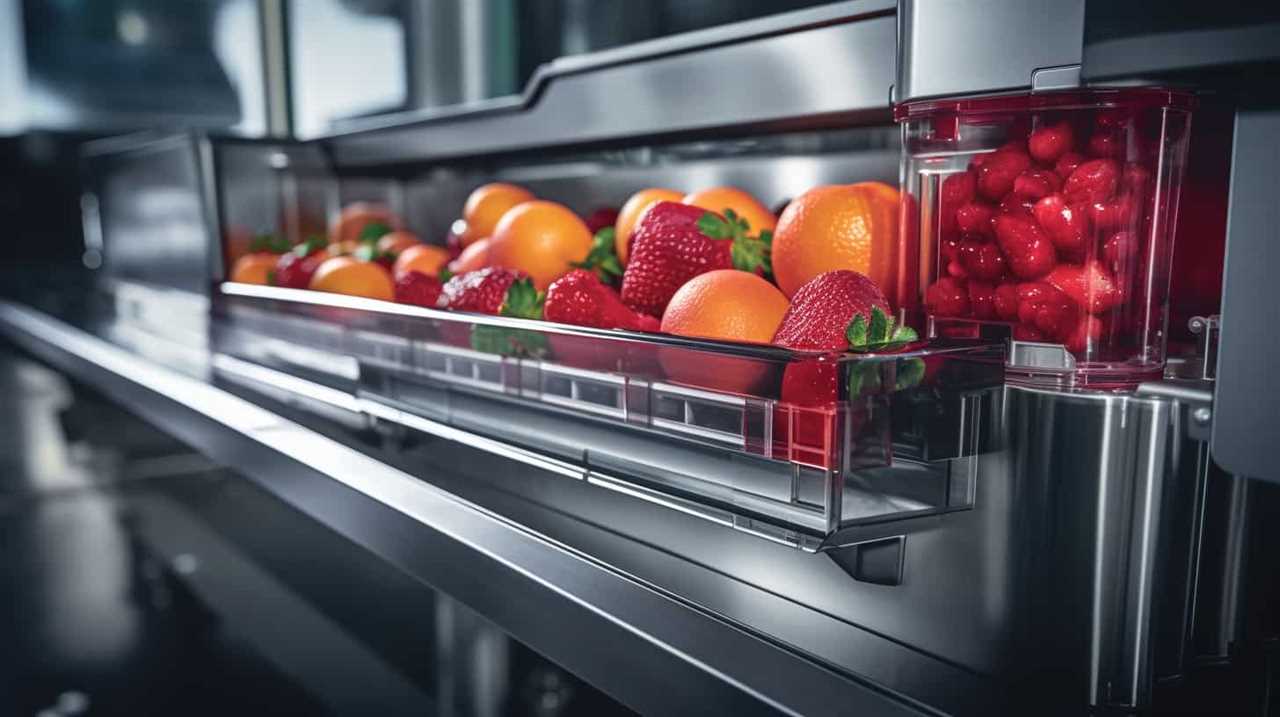
Light exposure can cause the degradation of vitamins, such as vitamin C, leading to a loss of nutritional value. Additionally, pigments in the juice, such as chlorophyll and carotenoids, can undergo photochemical reactions, resulting in color changes and off-flavors. Furthermore, light exposure can lead to the breakdown of antioxidants, reducing the juice’s ability to protect against oxidation.
To mitigate the negative effects of light exposure, it’s essential to use packaging materials that provide adequate light protection, such as opaque or tinted containers. Proper packaging can help maintain the quality and extend the shelf life of juice by minimizing juice oxidation caused by light exposure.
The Role of Temperature in Juice Packaging and Storage
Managing temperature is crucial for ensuring the quality and shelf life of juice during packaging and storage. The impact of temperature on beverage quality can’t be overstated. Here are three key points to consider when it comes to juice storage techniques and temperature:
- Temperature control: Maintaining a consistent temperature throughout the packaging and storage process is essential. Fluctuations in temperature can lead to microbial growth and spoilage, affecting the taste and safety of the juice.
- Cold chain management: Proper cold chain management is crucial to preserve the freshness and nutritional value of the juice. This involves keeping the juice at a controlled temperature from production to distribution to prevent degradation.
- Pasteurization: Heat treatment, such as pasteurization, is often used to kill harmful microorganisms in juice. It’s important to follow the recommended temperature and time parameters to ensure effective pasteurization without compromising the juice’s quality.
Understanding and implementing proper temperature control techniques is vital for maintaining the integrity of the juice.
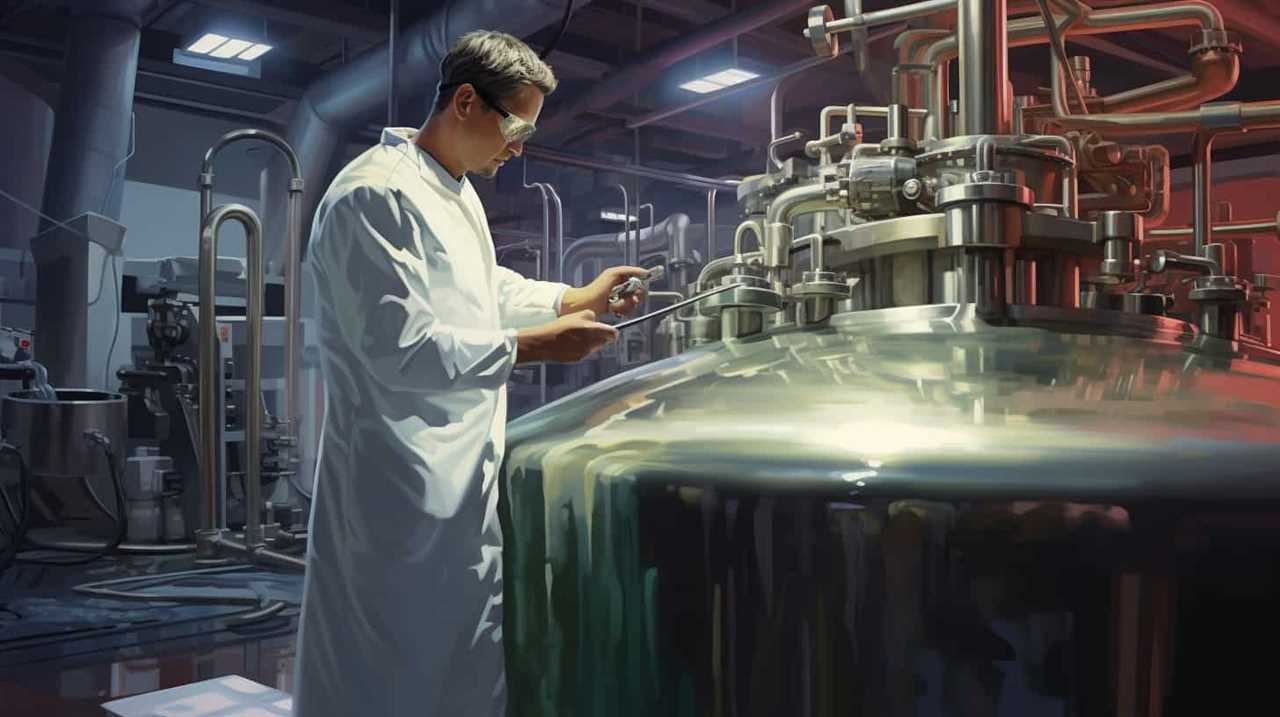
Now, let’s delve into the importance of proper sealing and packaging techniques.
Importance of Proper Sealing and Packaging Techniques
Now let’s delve into the significance of ensuring proper sealing and packaging techniques for maintaining the quality and shelf life of beverages.
Proper sealing and packaging techniques play a crucial role in preserving the integrity and freshness of beverages.
When beverages are improperly sealed or packaged, they’re exposed to external contaminants such as air, moisture, and light, which can accelerate the degradation process.

Proper sealing prevents air and moisture from seeping into the packaging, reducing the risk of microbial growth and oxidation.
Additionally, effective packaging techniques, such as using high-quality materials and employing airtight seals, can protect beverages from light exposure, which can lead to flavor degradation and nutrient loss.
Frequently Asked Questions
Can the Type of Packaging Material Affect the Taste or Flavor of the Juice?
Yes, the type of packaging material can affect the taste or flavor of the juice. Different materials can leach chemicals into the beverage, altering its flavor profile. It is important to choose packaging that is compatible with the beverage to maintain its taste integrity.
How Does Exposure to Oxygen Impact the Nutritional Value of the Juice?
Exposure to oxygen significantly impacts the nutritional value of juice. Studies show that oxidation caused by oxygen can lead to a decrease in vitamins and antioxidants. Packaging plays a crucial role in preventing this oxidation and maintaining juice quality.
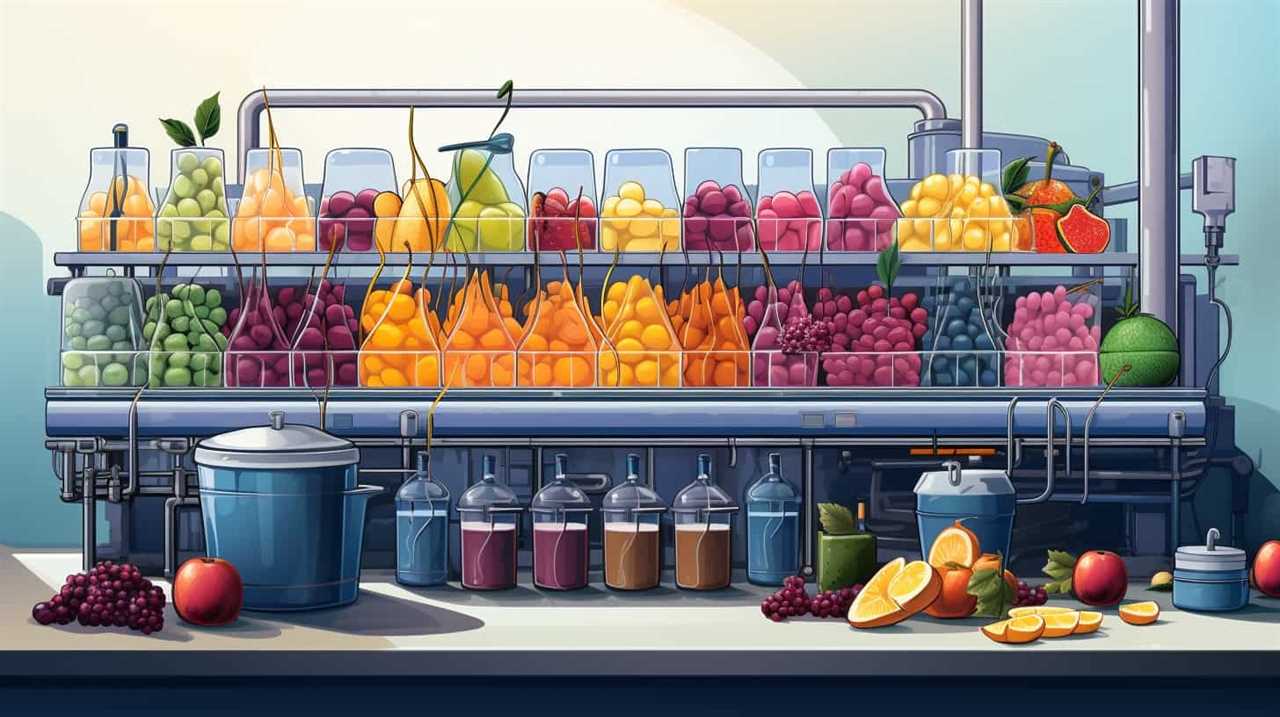
Can the Color of the Juice Be Affected by Exposure to Light?
Exposure to sunlight can impact the color of juice, causing it to change or fade. To prevent light exposure in juice packaging, opaque or dark-colored containers can be used to block out harmful rays and maintain the juice’s color.
Does the Temperature at Which Juice Is Stored Affect Its Shelf Life?
The shelf life of beverages can be affected by the storage temperature. Higher temperatures promote microbial growth, leading to spoilage. Proper temperature control is crucial to ensuring the longevity of packaged drinks.
Are There Any Specific Techniques or Methods for Ensuring Proper Sealing of Juice Packaging?
Proper sealing techniques and quality control measures are crucial for ensuring the longevity of beverage packaging. By implementing these methods, we can maintain the integrity of the packaging, thereby enhancing shelf life and customer satisfaction.
Conclusion
In conclusion, it’s imperative to understand that the choice of packaging for beverages plays a crucial role in determining their shelf life.
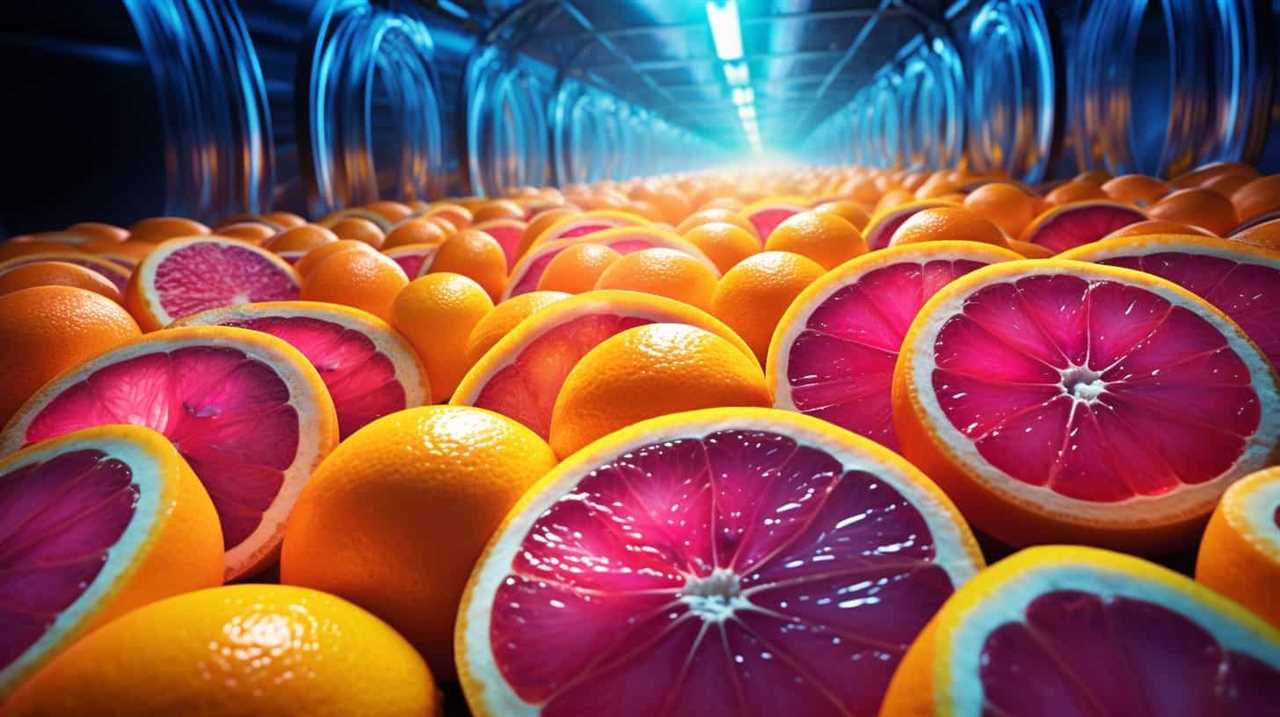
Factors such as oxygen exposure, light, temperature, and proper sealing techniques all contribute to the preservation of the product’s quality.
By carefully considering these aspects and utilizing appropriate packaging materials, producers can ensure that their beverages retain their freshness and appeal, delighting consumers with a euphoric sensory experience.
Susannah expertise lies in researching and compiling evidence-based content on juicing, nutrition, and overall health. She is committed to ensuring that The Juicery World offers accurate, up-to-date, and trustworthy information to empower readers to take control of their health. Susannah’s goal is to inspire individuals to embrace juicing as a way to nourish their bodies and live their best lives.
-

 Juice Tips and Tricks3 weeks ago
Juice Tips and Tricks3 weeks agoHow To Make Homemade Pickle Juice
-

 Health Benefits of Juice1 month ago
Health Benefits of Juice1 month agoHow Much Bottled Lemon Juice Equals 1 Lemon
-

 Juice Tips and Tricks1 week ago
Juice Tips and Tricks1 week agoHow Much Lemon Juice Is Equal To Half A Lemon
-

 Juice Tips and Tricks2 weeks ago
Juice Tips and Tricks2 weeks agoHow Much Lemon Juice Concentrate Equals One Lemon
-

 Popular Juice Brands3 months ago
Popular Juice Brands3 months ago10 Top-Rated Organic Juice Brands to Try
-

 Popular Juice Brands3 months ago
Popular Juice Brands3 months ago9 Best No-Sugar-Added Popular Juice Brands
-

 Juice Tips and Tricks2 days ago
Juice Tips and Tricks2 days agoHow Long Can You Drink Orange Juice After The Expiration Date
-

 Juice Tips and Tricks1 month ago
Juice Tips and Tricks1 month agoHow Long Does Lemon Juice Last After Expiration Date










